Európa állatkertjei
ZOOlogical Gardens of EuROPE
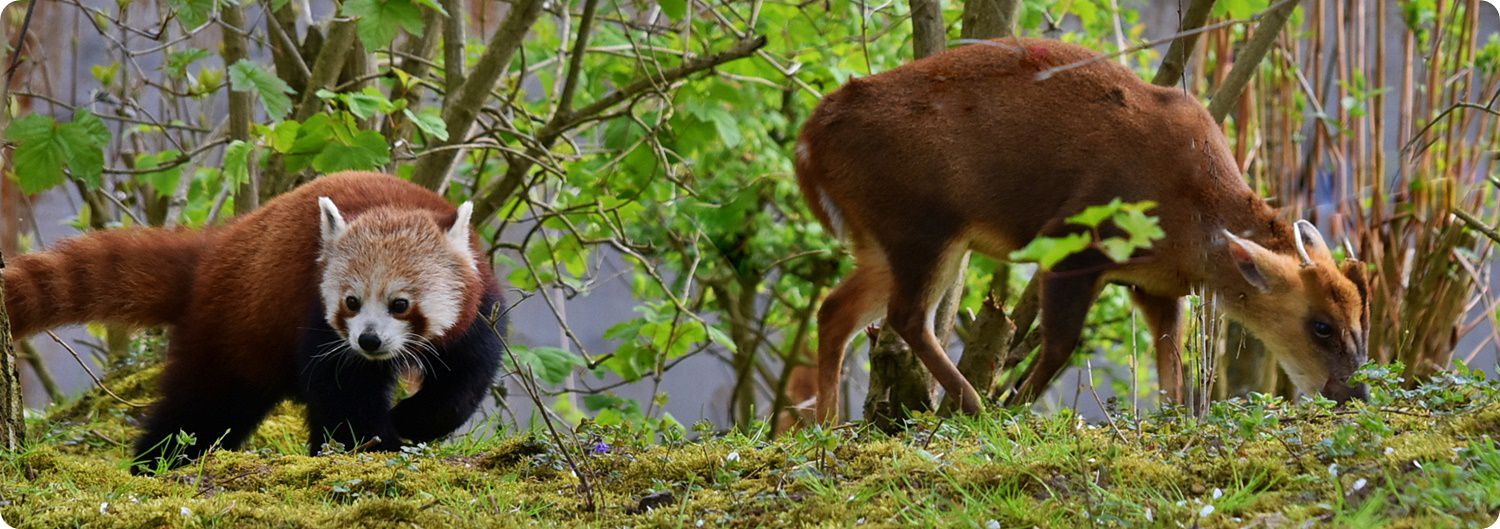
MIXED-SPECIES EXHIBITS WITH CARNIVORANS VII.
Mixed-species exhibits with Raccoons (Procyonidae) and Red Panda (Ailuridae)
Written by KRISZTIÁN SVÁBIK
Assistant Curator, Budapest Zoo and Botanical Garden, Hungary
Uploaded: 30th January 2019
Refreshed: 7th June 2020
INTRODUCTION
Within the narrower meaning of the mixed-species exhibits this document deals with six species of procyonids and the Red Panda.
In the list below you can see which species have been kept in mixed exhibits in captivity:
Raccoons, Procyonidae
Northern Raccoon, Procyon lotor Linnaeus, 1758
Crab-eating Raccoon, Procyon cancrivorus G. Baron Cuvier, 1798
South American Coati, Nasua nasua Linnaeus, 1766
White-nosed Coati, Nasua narica Linnaeus, 1766
Kinkajou, Potos flavus Schreber, 1774
Ringtail, Bassariscus astutus Lichtenstein, 1830
Red Panda, Ailuridae
Red Panda, Ailurus fulgens F.G. Cuvier, 1825
LIST OF SPECIES COMBINATIONS - PROCYONIDAE
The list shows examples of species combinations with at least one procyonid species combined with the taxa below
Northern Raccoon, Procyon lotor (Photo © Krisztián Svábik)
Opossum, Didelphis sp.
Common Marmoset, Callithrix jacchus
Woodchuck, Marmota monax
Crested Porcupine, Hystrix cristata
North American Porcupine, Erethizon dorsatum
Coypu, Myocastor coypus
Masked Palm Civet, Paguma larvata
Raccoon Dog, Nyctereutes procyonoides
Grey Fox, Urocyon cinereoargenteus
Arctic Fox, Alopex lagopus
Red Fox, Vulpes vulpes
Crab-eating Raccoon, Procyon cancrivorus
South American Coati, Nasua nasua
Striped Skunk, Mephitis mephitis
Western Polecat, Mustela putorius
European Mink, Mustela lutreola
American Mink, Neovison vison
Eurasian Otter, Lutra lutra
Asian Small-clawed Otter, Aonyx cinereus
American Badger, Taxidea taxus
Greater Hog Badger, Arctonyx collaris
Domestic Sheep, Ovis aries
Snapping Turtle, Chelydra serpentina
Alligator Snapping Turtle, Macrochelys temminckii
American Crocodile, Crocodylus acutus
American Alligator, Alligator mississippiensis
Florida Gar, Lepisosteus platyrhincus
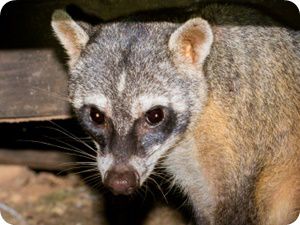 Crab-eating Raccoon, Procyon cancrivorus (Photo © Cláudio Dias Timm)
Crab-eating Raccoon, Procyon cancrivorus (Photo © Cláudio Dias Timm)
Bush Dog, Speothos venaticus
Northern Raccoon, Procyon lotor
White-nosed Coati, Nasua narica
Tayra, Eira barbara
South American Coati, Nasua nasua (Photo © Krisztián Svábik)
Large Hairy Armadillo, Chaetophractus villosus
Giant Anteater, Myrmecophaga tridactyla
Black Howler Monkey, Alouatta caraya
Geoffroy’s Spider Monkey, Ateles geoffroyi
Black-capped Capuchin, Sapajus apella
Bearded Capuchin, Sapajus libidinosus
Black-horned, Sapajus nigritus
Common Squirrel Monkey, Saimiri sciureus
Guinea Pig, Cavia porcellus
Agouti, Dasyprocta sp.
Patagonian Mara, Dolichotis patagonum
Capybara, Hydrochoerus hydrochaeris
Bush Dog, Speothos venaticus
Spectacled Bear, Tremarctos ornatus
Northern Raccoon, Procyon lotor
White-nosed Coati, Nasua narica
Striped Skunk, Mephitis mephitis
Tayra, Eira barbara
Asian Small-clawed Otter, Aonyx cinereus
South American Tapir, Tapirus terrestris
Collared Peccary, Pecari tajacu
White-lipped Peccary, Tayassu pecari
Chacoan Peccary, Catagonus wagneri
Southern Pudu, Pudu puda
Domestic Sheep, Ovis aries
White-nosed Coati, Nasua narica (Photo © Krisztián Svábik)
Six-banded Armadillo, Euphractus sexcinctus
Giant Anteater, Myrmecophaga tridactyla
Patagonian Mara, Dolichotis patagonum
Capybara, Hydrochoerus hydrochaeris
Bush Dog, Speothos venaticus
Crab-eating Raccoon, Procyon cancrivorus
South American Coati, Nasua nasua
Striped Skunk, Mephitis mephitis
South American Tapir, Tapirus terrestris
Collared Peccary, Pecari tajacu
Chacoan Peccary, Catagonus wagneri
Kinkajou, Potos flavus (Photo © Krisztián Svábik)
Short-beaked Echidna, Tachyglossus aculeatus
Nine-banded Armadillo, Dasypus novemcinctus
Six-banded Armadillo, Euphractus sexcinctus
Screaming Hairy Armadillo, Chaetophractus vellerosus
Large Hairy Armadillo, Chaetophractus villosus
Southern Three-banded Armadillo, Tolypeutes matacus
Linné’s Two-toed Sloth, Choloepus didactylus
Southern Tamandua, Tamandua tetradactyla
Ring-tailed Lemur, Lemur catta
Night Monkey, Aotus sp.
Common Squirrel Monkey, Saimiri sciureus
Brazilian Porcupine, Coendou prehensilis
Red-rumped Agouti, Dasyprocta leporina
Lowland Paca, Cuniculus paca
Seba’s Short-tailed Bat, Carollia perspicillata
Egyptian Fruit Bat, Rousettus aegyptiacus
Rosy-billed Pochard, Netta peposaca
Pig-nosed Turtle, Carettochelys insculpta
several fish species
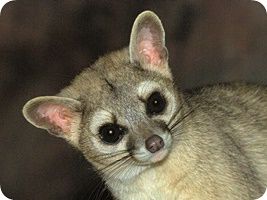 Ringtail, Bassariscus astutus (Photo © Burgers' Zoo)
Ringtail, Bassariscus astutus (Photo © Burgers' Zoo)
North American Porcupine, Erethizon dorsatum
Striped Skunk, Mephitis mephitis
LIST OF SPECIES COMBINATIONS - AILURIDAE
The list shows examples of species combinations with the Red Panda combined with the taxa below
Red Panda, Ailurus fulgens (Photo © Krisztián Svábik)
Short-beaked Echidna, Tachyglossus aculeatus
Siamang, Symphalangus syndactylus
Asian Small-clawed Otter, Aonyx cinerea
Tufted Deer, Elaphodus cephalophus
Indian Muntjac, Muntiacus muntjak
Reeves’ Muntjac, Muntiacus reevesi
Blackbuck, Antilope cervicapra
Himalayan Tahr, Hemitragus jemlahicus
Chinese Goral, Naemorhedus griseus
Urial, Ovis vignei
Southern Cassowary, Casuarius casuarius
Mandarin Duck, Aix galericulata
African Comb Duck, Sarkidiornis melanotos
Common Shelduck, Tadorna tadorna
Bewick’s Swan, Cygnus bewickii
White Eared-pheasant, Crossoptilon crossoptilon
Red-crowned Crane, Grus japonensis
Black-necked Crane, Grus nigricollis
White-naped Crane, Antigone vipio
Indian Peafowl, Pavo cristatus
Red-billed Blue Magpie, Urocissa erythrorhyncha
Crocodile, Crocodylus sp.
Koi, Cyprinus carpio
LIST OF MIXED-SPECIES EXHIBITS WITH LOCATIONS - PROCYONIDAE
The list shows specific examples of mixed-species exhibits involving at least one procyonid species combined with the taxa below, with indication of the institution(s) where they have been tried out
Northern Raccoon, Procyon lotor
Combined species:
- Northern Raccoon, Procyon lotor
- Opossum, Didelphis sp.
- Striped Skunk, Mephitis mephitis
unknown institution
Combined species:
- Northern Raccoon, Procyon lotor
- Common Marmoset, Callithrix jacchus
Institution(s): Riyadh Zoo (Saudi Arabia)
Combined species:
- Northern Raccoon, Procyon lotor
- Woodchuck, Marmota monax
Institution(s): Brookfield Zoo (Illinois, United States of America)
Combined species:
- Northern Raccoon, Procyon lotor
- Woodchuck, Marmota monax
- Striped Skunk, Mephitis mephitis
unknown institution
Combined species:
- Northern Raccoon, Procyon lotor
- Crested Porcupine, Hystrix cristata
Institution(s): Zoo Heidelberg (Germany)
Northern Raccoons (Procyon lotor) and Crested Porcupines (Hystrix cristata)
Zoo Heidelberg, Germany
Photo © Zoo Heidelberg
Combined species:
- Northern Raccoon, Procyon lotor
- North American Porcupine, Erethizon dorsatum
Institution(s): Tierpark Hirschfeld (Germany)
Combined species:
- Northern Raccoon, Procyon lotor
- Coypu, Myocastor coypus
Institution(s): Tierpark Hellabrunn (München, Germany), Zoo Děčín (Czech Republic)
Combined species:
- Northern Raccoon, Procyon lotor
- Masked Palm Civet, Paguma larvata
- Striped Skunk, Mephitis mephitis
- Greater Hog Badger, Arctonyx collaris
Institution(s): Shanghai Zoo (China)
Combined species:
- Northern Raccoon, Procyon lotor
- Raccoon Dog, Nyctereutes procyonoides
Institution(s): Wildpark Pforzheim (Germany), Greifvogelstation & Wildfreigehege Hellenthal (Germany), Solinger Vogel- und Tierpark (Germany), Tierpark Bern – Dählhölzli (Switzerland), Moscow Zoo (Russia), Kecskeméti Vadaskert (Hungary)
Raccoon Dog (Nyctereutes procyonoides) and Northern Raccoon (Procyon lotor)
Tierpark Bern - Dählhölzli, Switzerland
Photo © dr. Marc Rosset
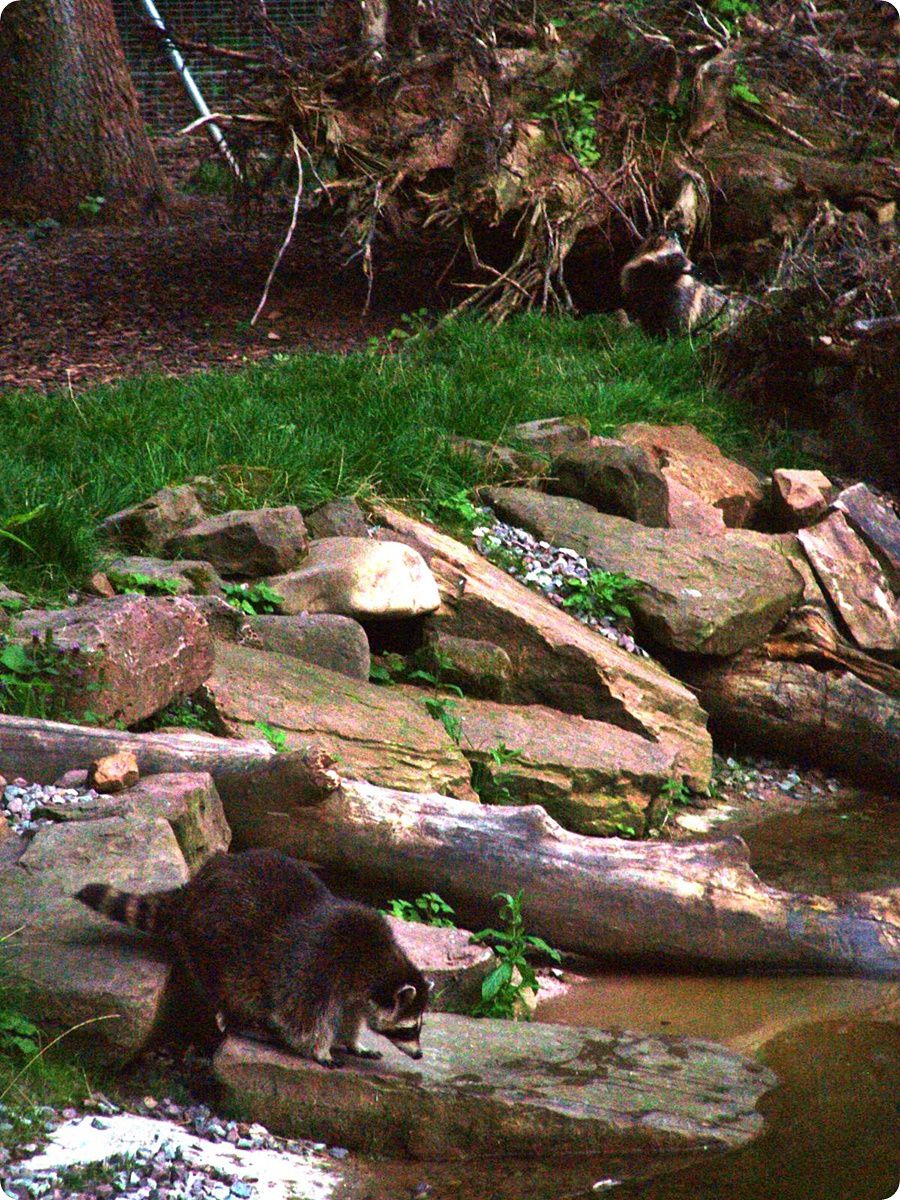
Northern Raccoon (Procyon lotor) and Raccoon Dog (Nyctereutes procyonoides)
Wildpark Pforzheim, Germany
Photo © Ben Gilbert
Combined species:
- Northern Raccoon, Procyon lotor
- Raccoon Dog, Nyctereutes procyonoides
- American Mink, Neovison vison
Institution(s): Wildpark Mölln (Germany)
Combined species:
- Northern Raccoon, Procyon lotor
- Arctic Fox, Alopex lagopus
unknown institution
Combined species:
- Northern Raccoon, Procyon lotor
- Grey Fox, Urocyon cinereoargenteus
Institution(s): The Texas Zoo (Victoria, Texas, United States of America)
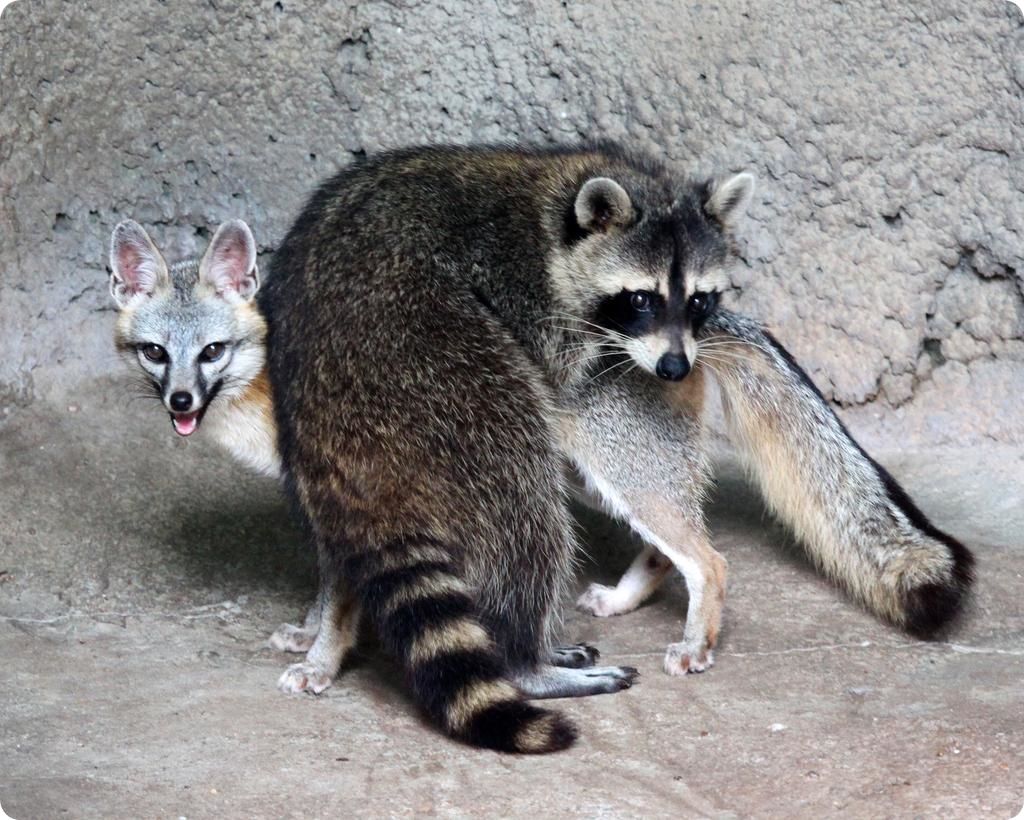
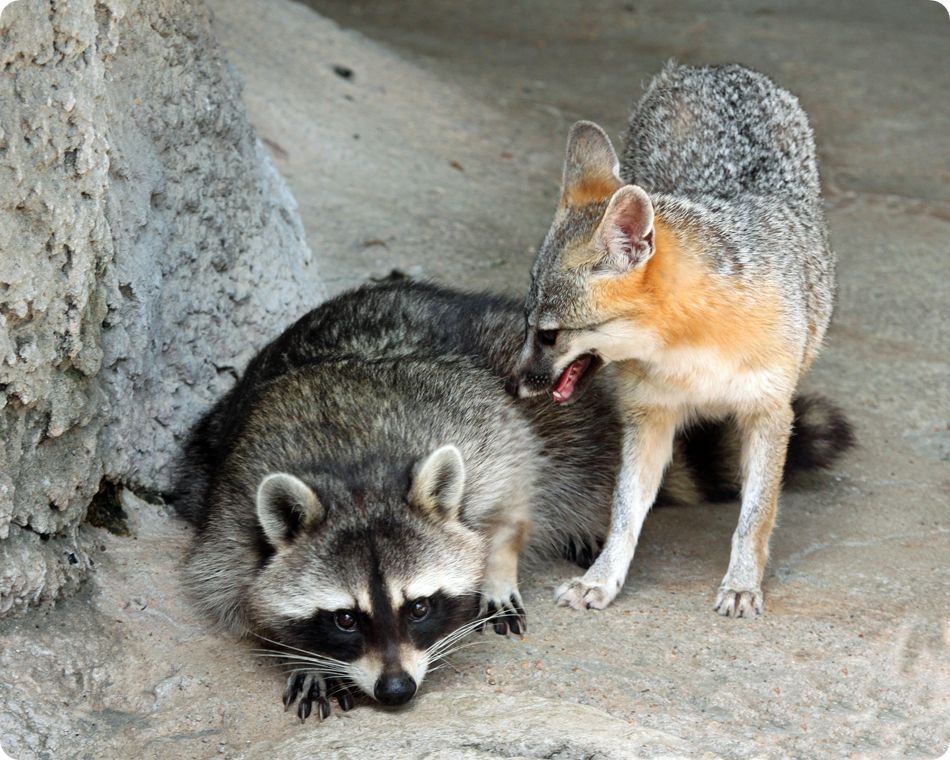
Northern Raccoon (Procyon lotor) and Grey Fox (Urocyon cinereoargenteus)
The Texas Zoo, Victoria, Texas, United States of America
Photo © www.deviantart.com
Combined species:
- Northern Raccoon, Procyon lotor
- Grey Fox, Urocyon cinereoargenteus
- Red Fox, Vulpes vulpes
Institution(s): Charles Towne Landing State Historic Site (South Carolina, United States of America)
Combined species:
- Northern Raccoon, Procyon lotor
- Red Fox, Vulpes vulpes
Institution(s): Minnesota Zoo (Minnesota, United States of America)
Combined species:
- Northern Raccoon, Procyon lotor
- Red Fox, Vulpes vulpes
- Striped Skunk, Mephitis mephitis
- Eurasian Otter, Lutra lutra
Institution(s): Zoo sauvage de Saint-Félicien (Québec, Canada)
Combined species:
- Northern Raccoon, Procyon lotor
- Crab-eating Raccoon, Procyon cancrivorus
Institution(s): Zoologischer Stadtgarten Karlsruhe (Germany), ZOO Antwerpen (Belgium)
Combined species:
- Northern Raccoon, Procyon lotor
- South American Coati, Nasua nasua
Institution(s): Wingham Wildlife Park (United Kingdom), Beale Park (Lower Basildon, United Kingdom), Zoo de Maubeuge (France)
Combined species:
- Northern Raccoon, Procyon lotor
- Striped Skunk, Mephitis mephitis
Institution(s): AquaZoo Friesland (Leeuwarden, the Netherlands), Dierenrijk (Mierlo, the Netherlands), GaiaZOO (Kerkrade, the Netherlands), ARTIS Amsterdam Royal Zoo (the Netherlands), ZOO Antwerpen (Belgium), Zoo Braunschweig „Arche Noah” (Germany), Zoo Stralsund (Germany), Heythrop Zoological Gardens (Chipping Norton, United Kingdom), Kecskeméti Vadaskert (Hungary), Tayto Park (Ashbourne, Ireland), Bronx Zoo (New York, United States of America)
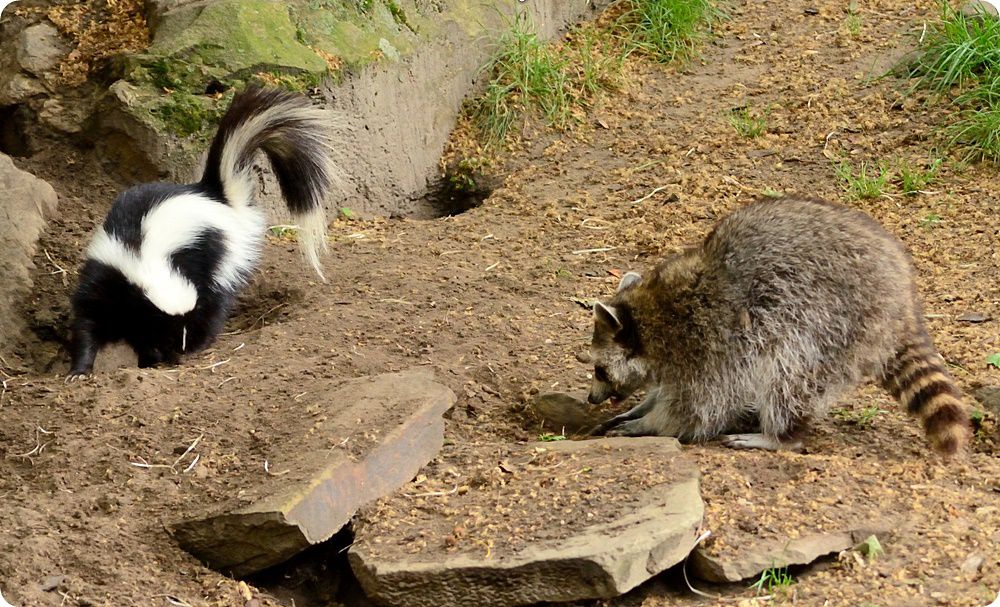
Northern Raccoon (Procyon lotor) and Striped Skunk (Mephitis mephitis)
ZOO Antwerpen, Belgium
Photo © Tom Van Deuren

Northern Raccoons (Procyon lotor) and Striped Skunk (Mephitis mephitis)
GaiaZOO, Kerkrade, the Netherlands
Photo © GaiaZOO
Northern Raccoons (Procyon lotor) and Striped Skunks (Mephitis mephitis)
GaiaZOO, Kerkrade, the Netherlands
Photo © Örs Görög
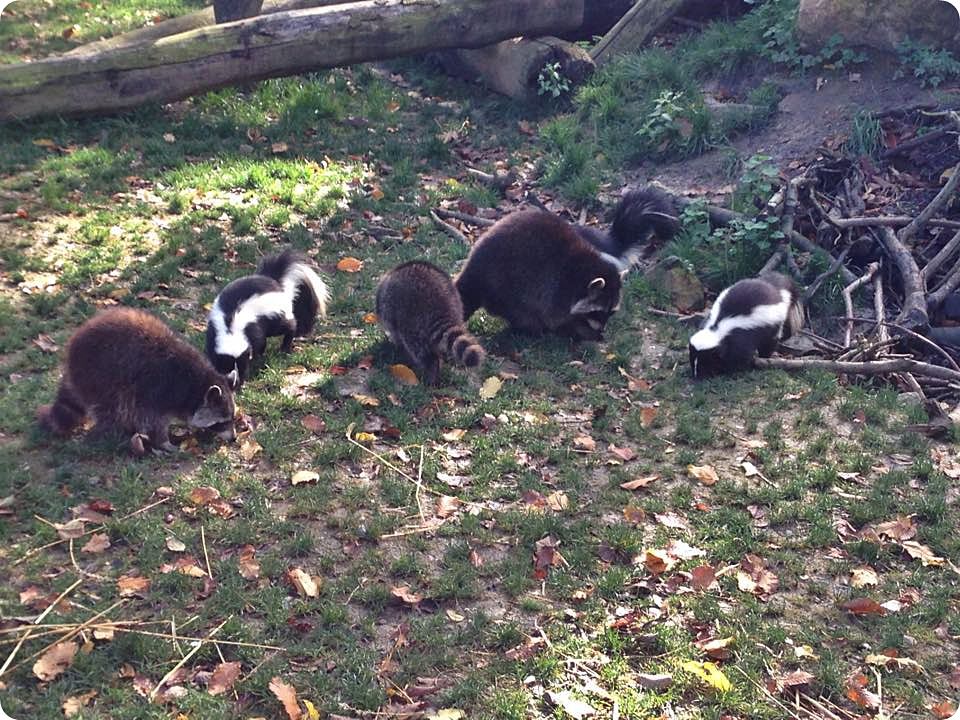
Northern Raccoons (Procyon lotor) and Striped Skunks (Mephitis mephitis)
GaiaZOO, Kerkrade, the Netherlands
Photo © Mario Berndtgen
Northern Raccoon (Procyon lotor) and Striped Skunk (Mephitis mephitis)
Heythrop Zoological Gardens, Chipping Norton, United Kingdom
Photo © Paul Irven
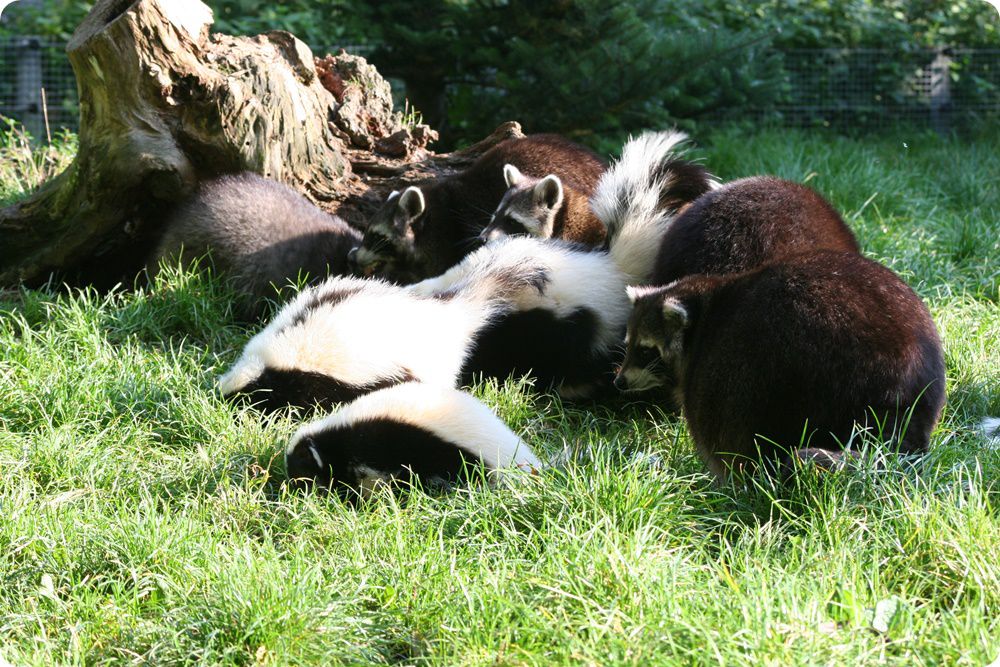
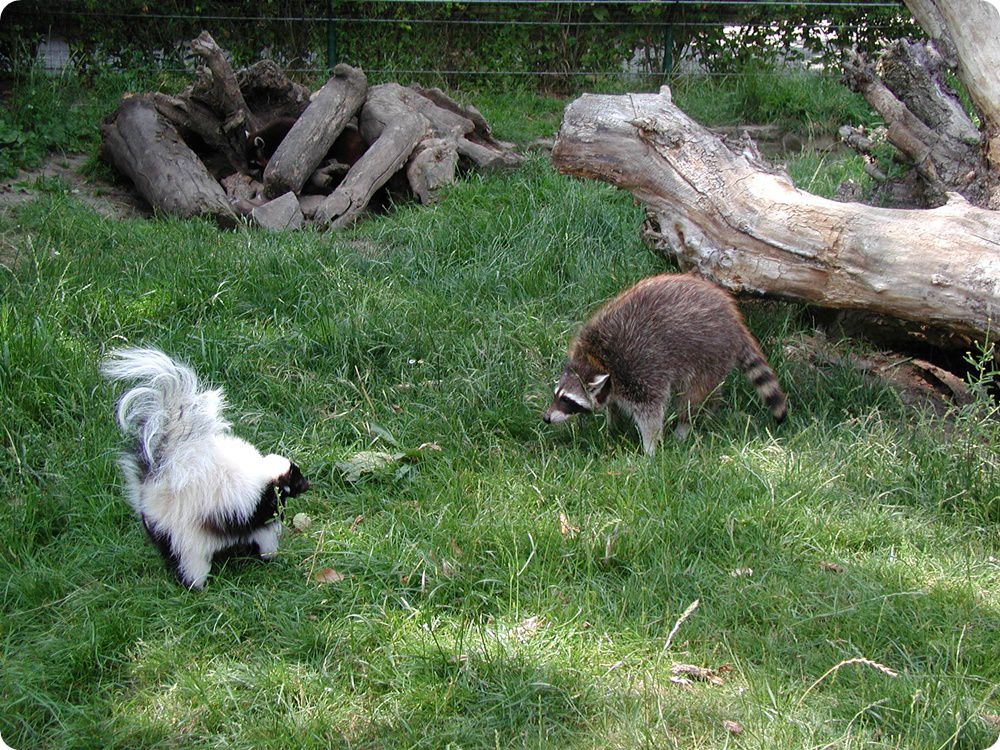
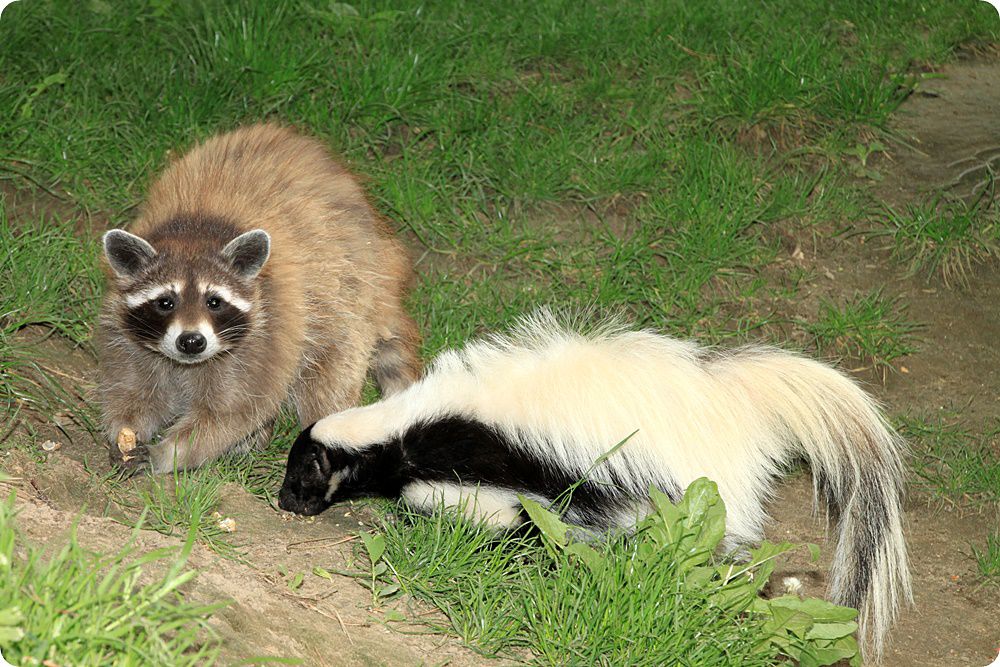
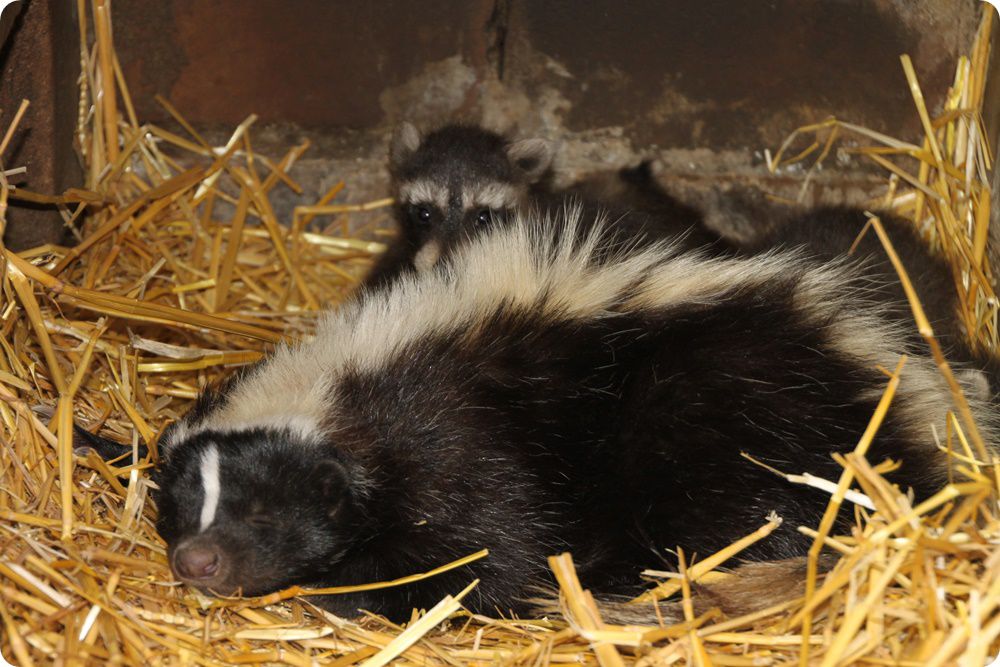
Northern Raccoons (Procyon lotor) and Striped Skunks (Mephitis mephitis)
Zoo Braunschweig „Arche Noah”, Germany
Photos © Zoo Braunschweig „Arche Noah”
Combined species:
- Northern Raccoon, Procyon lotor
- American Badger, Taxidea taxus
Institution(s): Los Angeles Zoo (California, United States of America)
Combined species:
- Northern Raccoon, Procyon lotor
- European Polecat, Mustela putorius
Institution(s): Tierpark Gotha (Germany), Tierpark Hexentanzplatz (Thale, Germany)
Combined species:
- Northern Raccoon, Procyon lotor
- Ferret, Mustela putorius f. furo
Institution(s): Wildpark Bad Mergentheim (Germany), Wildparadies Tripsdrill (Cleebronn, Germany)
Combined species:
- Northern Raccoon, Procyon lotor
- European Mink, Mustela lutreola
Institution(s): Zoo Heidelberg (Germany)
Combined species:
- Northern Raccoon, Procyon lotor
- American Mink, Neovison vison
Institution(s): Parc Animalier des Pyrénées (Ayzac-Ost, France)
Combined species:
- Northern Raccoon, Procyon lotor
- Eurasian Otter, Lutra lutra
Institution(s): Zoo Rostock (Germany), Tierpark Görlitz (Germany), Tierpark Niederfischbach (Germany)
Combined species:
- Northern Raccoon, Procyon lotor
- Asian Small-clawed Otter, Aonyx cinereus
Institution(s): Aachener Tierpark Euregiozoo (Germany)
Combined species:
- Northern Raccoon, Procyon lotor
- Quessant Sheep, Ovis aries
Institution(s): Podkrušnohorský zoopark Chomutov (Czech Republic)
Combined species:
- Northern Raccoon, Procyon lotor
- Snapping Turtle, Chelydra serpentina
- Alligator Snapping Turtle, Macrochelys temminckii
- American Crocodile, Crocodylus acutus
- American Alligator, Alligator mississippiensis
- Florida Gar, Lepisosteus platyrhincus
Institution(s): Omaha's Henry Doorly Zoo and Aquarium (Nebraska, United States of America)
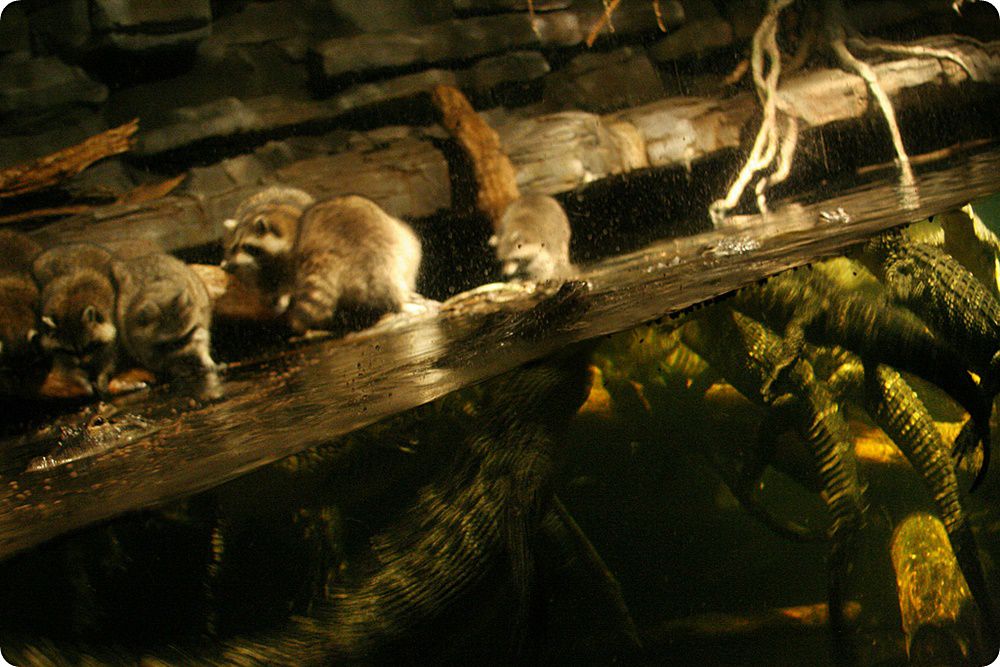
Northern Raccoons (Procyon lotor) and American Alligators (Alligator mississippiensis)
Omaha's Henry Doorly Zoo and Aquarium, Nebraska, United States of America
Photo © www.hiveminer.com
 Crab-eating Raccoon, Procyon cancrivorus
Crab-eating Raccoon, Procyon cancrivorus
Combined species:
- Crab-eating Raccoon, Procyon cancrivorus
- Bush Dog, Speothos venaticus
- White-nosed Coati, Nasua narica
Institution(s): ZooParc Overloon (the Netherlands)
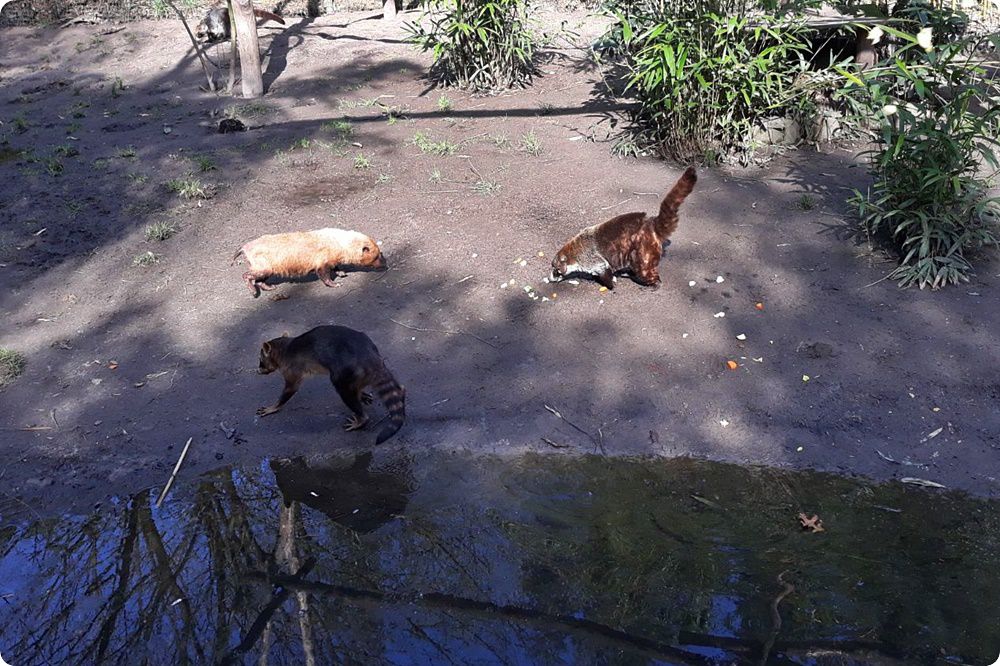
Crab-eating Raccoon (Procyon cancrivorus), Bush Dog (Speothos venaticus) and White-nosed Coati (Nasua narica)
ZooParc Overloon, the Netherlands
Photo © Steven van den Heuvel
Combined species:
- Crab-eating Raccoon, Procyon cancrivorus
- Northern Raccoon, Procyon lotor
Institution(s): Zoologischer Stadtgarten Karlsruhe (Germany), ZOO Antwerpen (Belgium)
Combined species:
- Crab-eating Raccoon, Procyon cancrivorus
- Tayra, Eira barbara
Institution(s): Eco Zoologico San Martín (Banos, Ecuador)
South American Coati, Nasua nasua
Combined species:
- South American Coati, Nasua nasua
- Large Hairy Armadillo, Chaetophractus villosus
Institution(s): Śląski Ogród Zoologiczny (Chorzów, Poland)
Combined species:
- South American Coati, Nasua nasua
- Giant Anteater, Myrmecophaga tridactyla
Institution(s): Yorkshire Wildlife Park (Branton, United Kingdom)
Combined species:
- South American Coati, Nasua nasua
- Giant Anteater, Myrmecophaga tridactyla
- Capybara, Hydrochoerus hydrochaeris
Institution(s): Loro Parque (Puerto de la Cruz, Santa Cruz de Tenerife, Spain)
Combined species:
- South American Coati, Nasua nasua
- Black Howler Monkey, Alouatta caraya
- Patagonian Mara, Dolichotis patagonum
Institution(s): Twycross Zoo (United Kingdom)
Combined species:
- South American Coati, Nasua nasua
- Black Howler Monkey, Alouatta caraya
- Spectacled Bear, Tremarctos ornatus
- Asian Small-clawed Otter, Aonyx cinereus
Institution(s): Jersey Zoo (Trinity, Channel Islands)
Combined species:
- South American Coati, Nasua nasua
- Geoffroy’s Spider Monkey, Ateles geoffroyi
Institution(s): Los Angeles Zoo (California, United States of America)
Combined species:
- South American Coati, Nasua nasua
- Black-capped Capuchin, Sapajus apella
Institution(s): Plaswijckpark (Rotterdam, the Netherlands), BestZOO (the Netherlands), Landgoed Hoenderdaell (Anna Paulowna, the Netherlands), Zoo Rostock (Germany), Zoološki vrt grada Zagreba (Croatia)
Combined species:
- South American Coati, Nasua nasua
- Black-capped Capuchin, Sapajus apella
- Tayra, Eira barbara
Institution(s): Parque de las Leyendas (Lima, Peru)
South American Coati (Nasua nasua) and Black-capped Capuchins (Sapajus apella)
Parque de las Leyendas, Lima, Peru
Photo © Nick Hadad
Combined species:
- South American Coati, Nasua nasua
- Black-capped Capuchin, Sapajus apella
- Capybara, Hydrochoerus hydrochaeris
- Agouti, Dasyprocta sp.
Institution(s): Parque de las Leyendas (Lima, Peru)
Combined species:
- South American Coati, Nasua nasua
- Black-horned Capuchin, Sapajus nigritus
Institution(s): Parque Zoológico Huachipa (Ate, Peru)
South American Coatis (Nasua nasua) and Black-horned Capuchins (Sapajus nigritus)
Parque Zoológico Huachipa, Ate, Peru
Photo © Alexander Meyer
Combined species:
- South American Coati, Nasua nasua
- Bearded Capuchin, Sapajus libidinosus
- Collared Peccary, Pecari tajacu
Institution(s): Zoologischer Garten Schwerin (Germany)
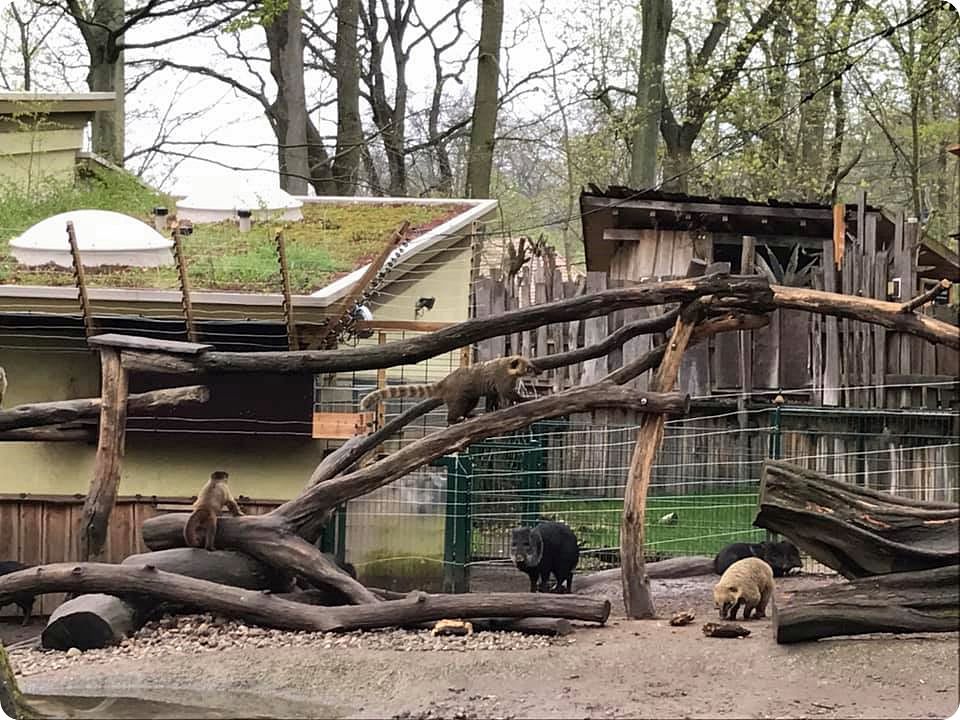
South American Coatis (Nasua nasua), Bearded Capuchins (Sapajus libidinosus) and Collared Peccaries (Pecari tajacu)
Zoologischer Garten Schwerin, Germany
Photo © Mario Berndtgen
Combined species:
- South American Coati, Nasua nasua
- Capuchin, Sapajus sp.
- Collared Peccary, Pecari tajacu
Institution(s): Zoo Salzburg Hellbrunn (Austria)
Combined species:
- South American Coati, Nasua nasua
- Common Squirrel Monkey, Saimiri sciureus
Institution(s): Fővárosi Állat- és Növénykert (Budapest, Hungary)
Combined species:
- South American Coati, Nasua nasua
- Guinea Pig, Cavia porcellus
Institution(s): Adelaide Zoo (South Australia, Australia)
Combined species:
- South American Coati, Nasua nasua
- Capybara, Hydrochoerus hydrochaeris
- Southern Pudu, Pudu puda
Institution(s): Detroit Zoo (Royal Oak, Michigan, United States of America)
Combined species:
- South American Coati, Nasua nasua
- Bush Dog, Speothos venaticus
Institution(s): Twycross Zoo (United Kingdom), Parc Zoologique de Paris (France)
South American Coatis (Nasua nasua) and Bush Dog (Speothos venaticus)
Twycross Zoo, United Kingdom
Photos © www.zoochat.com and Ben Gilbert
Combined species:
- South American Coati, Nasua nasua
- Sun Bear, Helarctos malayanus
Institution(s): Zoo Aquarium de Madrid (Spain)
Combined species:
- South American Coati, Nasua nasua
- Spectacled Bear, Tremarctos ornatus
Institution(s): Los Angeles Zoo (California, United States of America), Racine Zoo (Wisconsin,United States of America), ZOO Antwerpen (Belgium), ARTIS Amsterdam Royal Zoo (the Netherlands), Chester Zoo (United Kingdom), Port Lympne Wild Animal Park (United Kingdom), Noah’s Ark Zoo Farm (Wraxall, United Kingdom), Zoo Zürich (Switzerland), Zoo Aquarium de Madrid (Spain), Zoo de Pont Scorff (France)

Spectacled Bear (Tremarctos ornatus) and South American Coatis (Nasua nasua)
ZOO Antwerpen, Belgium
Photo © www.zoochat.com
Spectacled Bear (Tremarctos ornatus) and South American Coati (Nasua nasua)
Zoo Zürich, Switzerland
Photo © Krisztián Svábik
.jpg)
Spectacled Bear (Tremarctos ornatus) and South American Coati (Nasua nasua) mixed exhibit
Chester Zoo, United Kingdom
Photo © Krisztián Svábik
Spectacled Bear (Tremarctos ornatus) and South American Coati (Nasua nasua)
Zoo Aquarium de Madrid, Spain
Photo © Zoo Aquarium de Madrid
Combined species:
- South American Coati, Nasua nasua
- Striped Skunk, Mephitis mephitis
Institution(s): Opel-Zoo (Kronberg, Germany)
Combined species:
- South American Coati, Nasua nasua
- Asian Small-clawed Otter, Aonyx cinereus
Institution(s): Apenheul (Apeldoorn, the Netherlands)
Combined species:
- South American Coati, Nasua nasua
- Nothern Raccoon, Procyon lotor
Institution(s): Wingham Wildlife Park (United Kingdom), Beale Park (Lower Basildon, United Kingdom), Zoo de Maubeuge (France)
Combined species:
- South American Coati, Nasua nasua
- White-nosed Coati, Nasua narica
Institution(s): Tiergarten Schönbrunn (Vienna, Austria), Oakland Zoo (California, United States of America)
Combined species:
- South American Coati, Nasua nasua
- White-nosed Coati, Nasua narica
- Patagonian Mara, Dolichotis patagonum
Institution(s): Zoologická zahrada hl. m. Prahy (Czech Republic)
Combined species:
- South American Coati, Nasua nasua
- White-nosed Coati, Nasua narica
- Chacoan Peccary, Catagonus wagneri
Institution(s): ZOO Planckendael (Mechelen, Belgium)
Combined species:
- South American Coati, Nasua nasua
- Collared Peccary, Pecari tajacu
Institution(s): Zoologická a botanická zahrada města Plzně (Czech Republic), Zoologická zahrada Liberec (Czech Republic), ZOO a zámek Zlín-Lešná (Czech Republic), Zoologischer Garten Schwerin (Germany), Tier- und Freizeitpark Eichholz Gemendorf (Germany), Spaycific Zoo (Spay, France), Miskolci Állatkert és Kultúrpark (Hungary)
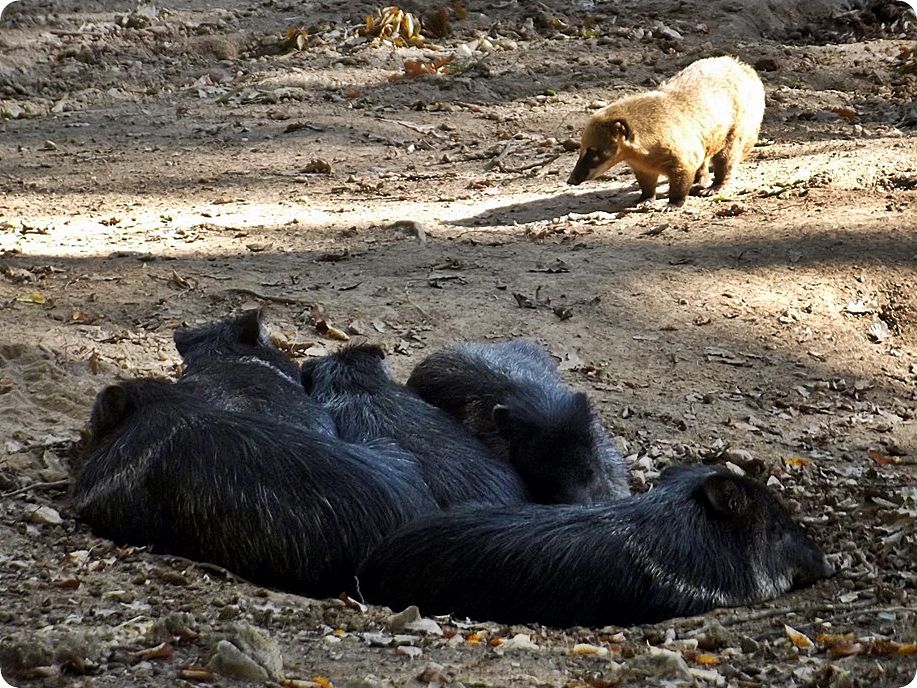
South American Coati (Nasua nasua) and Collared Peccaries (Pecari tajacu)
Miskolci Állatkert és Kultúrpark, Hungary
Photo © Antal Nagy
South American Coatis (Nasua nasua) and Collared Peccaries (Pecari tajacu)
Zoologická zahrada Liberec, Czech Republic
Photo © www.zoochat.com
Combined species:
- South American Coati, Nasua nasua
- White-lipped Peccary, Tayassu pecari
Institution(s): ZOO Planckendael (Mechelen, Belgium)
Combined species:
- South American Coati, Nasua nasua
- South American Tapir, Tapirus terrestris
Institution(s): Zoologischer Garten Magdeburg (Germany)
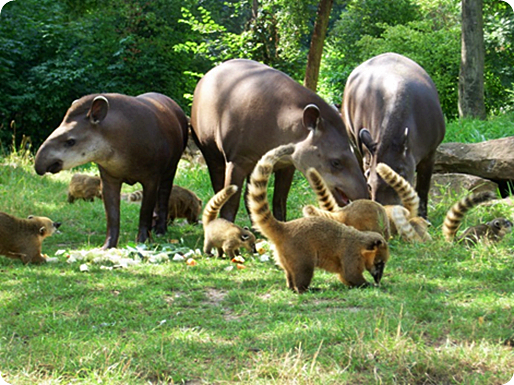
South American Coatis (Nasua nasua) and South American Tapirs (Tapirus terrestris)
Zoologischer Garten Magdeburg, Germany
Photo © Konstantin Ruske
Combined species:
- South American Coati, Nasua nasua
- Somali Black-headed Sheep, Ovis aries
Institution(s): Tiergarten Schönbrunn (Vienna, Austria)
South American Coatis (Nasua nasua) and Somali Black-headed Sheep (Ovis aries)
Tiergarten Schönbrunn, Vienna, Austria
Photo © Andrew O'Connor
Combined species:
- South American Coati, Nasua nasua
- Quessant Sheep, Ovis aries
Institution(s): Živalski Vrt Sikalu ZOO (Boračeva, Slovenia)
White-nosed Coati, Nasua narica
Combined species:
- White-nosed Coati, Nasua narica
- Six-banded Armadillo, Euphractus sexcinctus
Institution(s): Zoo of the University of Mato Grosso (Cuiabá, Brazil)
Combined species:
- White-nosed Coati, Nasua narica
- Giant Anteater, Myrmecophaga tridactyla
Institution(s): Fresno Chaffee Zoo (California, United States of America)
Combined species:
- White-nosed Coati, Nasua narica
- Capybara, Hydrochoerus hydrochaeris
unknown institution
Combined species:
- White-nosed Coati, Nasua narica
- Bush Dog, Speothos venaticus
- Crab-eating Raccoon, Procyon cancrivorus
Institution(s): ZooParc Overloon (the Netherlands)
Combined species:
- White-nosed Coati, Nasua narica
- South American Coati, Nasua nasua
Institution(s): Tiergarten Schönbrunn (Vienna, Austria), Oakland Zoo (California, United States of America)
Combined species:
- White-nosed Coati, Nasua narica
- South American Coati, Nasua nasua
- Patagonian Mara, Dolichotis patagonum
Institution(s): Zoologická zahrada hl. m. Prahy (Czech Republic)
Combined species:
- White-nosed Coati, Nasua narica
- South American Coati, Nasua nasua
- Chacoan Peccary, Catagonus wagneri
Institution(s): ZOO Planckendael (Mechelen, Belgium)
Combined species:
- White-nosed Coati, Nasua narica
- Chacoan Peccary, Catagonus wagneri
Institution(s): Zoo Leipzig (Germany)
Combined species:
- White-nosed Coati, Nasua narica
- Collared Peccary, Pecari tajacu
Institution(s): Papiliorama (Kerzers, Switzerland)
White-nosed Coati (Nasua narica) and Collared Peccary (Pecari tajacu)
Papiliorama, Kerzers, Switzerland
Photo © Krisztián Svábik
Combined species:
- White-nosed Coati, Nasua narica
- Striped Skunk, Mephitis mephitis
Institution(s): Keepers of the Wild (Valentine, Arizona, United States of America)
Combined species:
- White-nosed Coati, Nasua narica
- South American Tapir, Tapirus terrestris
Institution(s): Zoologischer Garten Magdeburg (Germany)
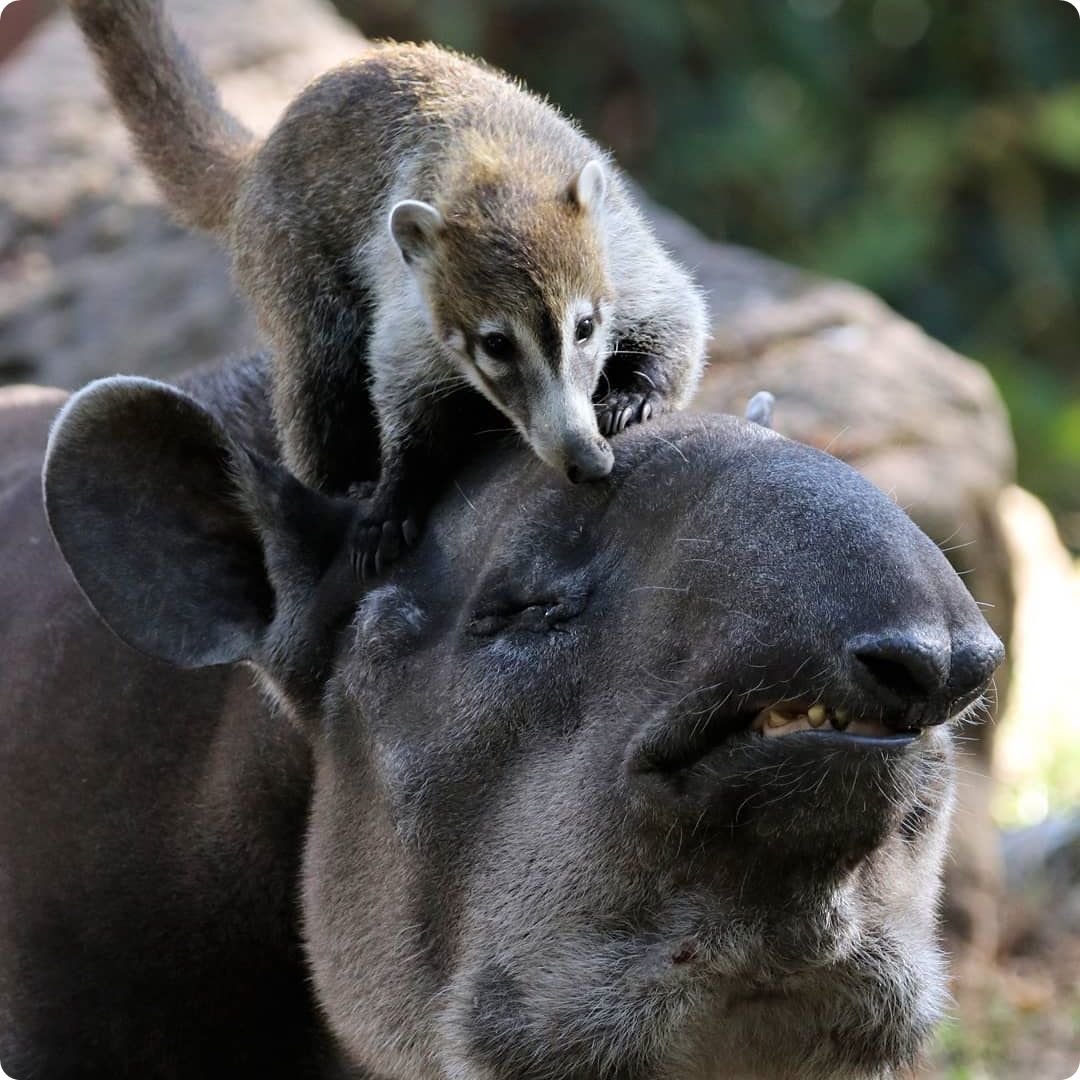
White-nosed Coati (Nasua narica) and South American Tapir (Tapirus terrestris)
Zoologischer Garten Magdeburg, Germany
Photo © René Bildermax
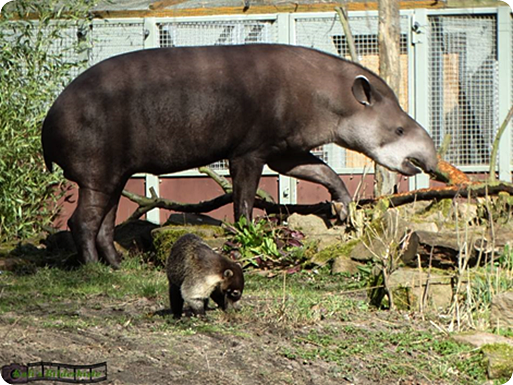
White-nosed Coati (Nasua narica) and South American Tapir (Tapirus terrestris)
Zoologischer Garten Magdeburg, Germany
Photo © Konstantin Ruske
Kinkajou, Potos flavus
Combined species:
- Kinkajou, Potos flavus
- Short-beaked Echidna, Tachyglossus aculeatus
Institution(s): Skansen-Akvariet (Stockholm, Sweden)
Combined species:
- Kinkajou, Potos flavus
- Southern Three-banded Armadillo, Tolypeutes matacus
- Screaming Hairy Armadillo, Chaetophractus vellerosus
- Large Hairy Armadillo, Chaetophractus villosus
- Linné’s Two-toed Sloth, Choloepus didactylus
- Night Monkey, Aotus sp.
- Brazilian Porcupine, Coendou prehensilis
- Red-rumped Agouti, Dasyprocta leporina
Institution(s): Omaha's Henry Doorly Zoo and Aquarium (Nebraska, United States of America)
Combined species:
- Kinkajou, Potos flavus
- Large Hairy Armadillo, Chaetophractus villosus
- Egyptian Fruit Bat, Rousettus aegyptiacus
Institution(s): Nowe Zoo - Ogród Zoologiczny w Poznaniu (Poland)
Combined species:
- Kinkajou, Potos flavus
- Nine-banded Armadillo, Dasypus novemcinctus
- Lowland Paca, Cuniculus paca
- Seba’s Short-tailed Bat, Carollia perspicillata
Institution(s): Papiliorama (Kerzers, Switzerland)
Combined species:
- Kinkajou, Potos flavus
- Six-banded Armadillo, Euphractus sexcinctus
- Linné’s Two-toed Sloth, Choloepus didactylus
- Seba’s Short-tailed Bat, Carollia perspicillata
Institution(s): Papiliorama (Kerzers, Switzerland)
Combined species:
- Kinkajou Potos flavus
- Six-banded Armadillo, Euphractus sexcinctus
- Linné’s Two-toed Sloth, Choloepus didactylus
- Red-rumped Agouti, Dasyprocta leporina
Institution(s): Memphis Zoo (Tennessee, United States of America)
Combined species:
- Kinkajou, Potos flavus
- Linné’s Two-toed Sloth, Choloepus didactylus
Institution(s): Wildlife Learning Center (Los Angeles, California, United States of America)
Combined species:
- Kinkajou, Potos flavus
- Linné’s Two-toed Sloth, Choloepus didactylus
- Night Monkey, Aotus sp.
Institution(s): Cincinnati Zoo & Botanical Garden (Ohio, United States of America)
Combined species:
- Kinkajou, Potos flavus
- Armadillo, Cingulata
- Southern Tamandua, Tamandua tetradactyla
- Ring-tailed Lemur, Lemur catta
- Rosy-billed Pochard, Netta peposaca
- Pig-nosed Turtle, Carettochelys insculpta
- several fish species
Institution(s): Sunshine Aquarium (Tokyo, Japan)
Combined species:
- Kinkajou, Potos flavus
- Common Squirrel Monkey, Saimiri sciureus
Institution(s): Kecskeméti Vadaskert (Hungary)
Combined species:
- Kinkajou, Potos flavus
- Brazilian Porcupine, Coendou prehensilis
Institution(s): Zoo Brno (Czech Republic)
 Ringtail, Bassariscus astutus
Ringtail, Bassariscus astutus
Combined species:
- Ringtail, Bassariscus astutus
- North American Porcupine, Erethizon dorsatum
Institution(s): Fort Worth Zoo (Texas, United States of America)
Combined species:
- Ringtail, Bassariscus astutus
- Striped Skunk, Mephitis mephitis
Institution(s): Koninklijke Burgers’ Zoo (Arnhem, the Netherlands)
LIST OF MIXED-SPECIES EXHIBITS WITH LOCATIONS - AILURIDAE
The list shows specific examples of mixed-species exhibits involving the Red Panda combined with the taxa below, with indication of the institution(s) where they have been tried out
Red Panda, Ailurus fulgens
Combined species:
- Red Panda, Ailurus fulgens
- Short-beaked Echidna, Tachyglossus aculeatus
Institution(s): Paignton Zoo Environmental Park (United Kingdom)
Combined species:
- Red Panda, Ailurus fulgens
- Siamang, Symphalangus syndactylus
Institution(s): Zoo Osnabrück (Germany)
Combined species:
- Red Panda, Ailurus fulgens
- Asian Small-clawed Otter, Aonyx cinereus
Institution(s): Welsh Mountain Zoo (Colwyn Bay, United Kingdom), ZooParc Overloon (the Netherlands), AquaZoo Friesland (Leeuwarden, the Netherlands)
Western Red Panda (Ailurus fulgens fulgens) and Asian Small-clawed Otter (Aonyx cinereus) mixed exhibit
Welsh Mountain Zoo, Colwyn Bay, United Kingdom
Photo © Ben Gilbert
Combined species:
- Red Panda, Ailurus fulgens
- Asian Small-clawed Otter, Aonyx cinereus
- Reeves’ Muntjac, Muntiacus reevesi
Institution(s): Parc Zoologique et Botanique de Mulhouse (France)
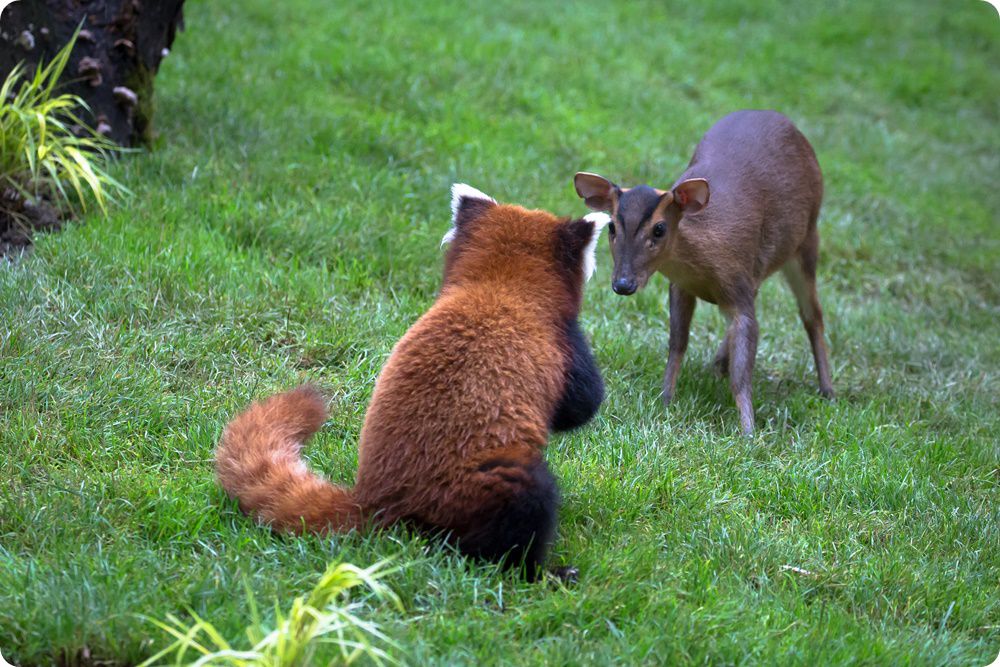
Western Red Panda (Ailurus fulgens fulgens) and Reeves' Muntjac (Muntiacus reevesi)
Parc Zoologique et Botanique de Mulhouse, France
Photo © Dominique Villiseck
Combined species:
- Red Panda, Ailurus fulgens
- Michie’s Tufted Deer, Elaphodus cephalophus michianus
Institution(s): Diergaarde Blijdorp (Rotterdam, the Netherlands), Zoo Heidelberg (Germany), Zoo Leipzig (Germany), ZOO Wrocław (Poland)
Western Red Panda (Ailurus fulgens fulgens) and Michie's Tufted Deer (Elaphodus cephalophus michianus)
Zoo Heidelberg, Germany
Photos © Allan Galway and Zoo Heidelberg
Western Red Panda (Ailurus fulgens fulgens) and Michie's Tufted Deer (Elaphodus cephalophus michianus)
Zoo Heidelberg, Germany
Photo © Zoo Heidelberg
Combined species:
- Red Panda, Ailurus fulgens
- Indian Muntjac, Muntiacus muntjak
Institution(s): Zoo Heidelberg (Germany), Sequioa Park Zoo (Eureka, California, United States of America)
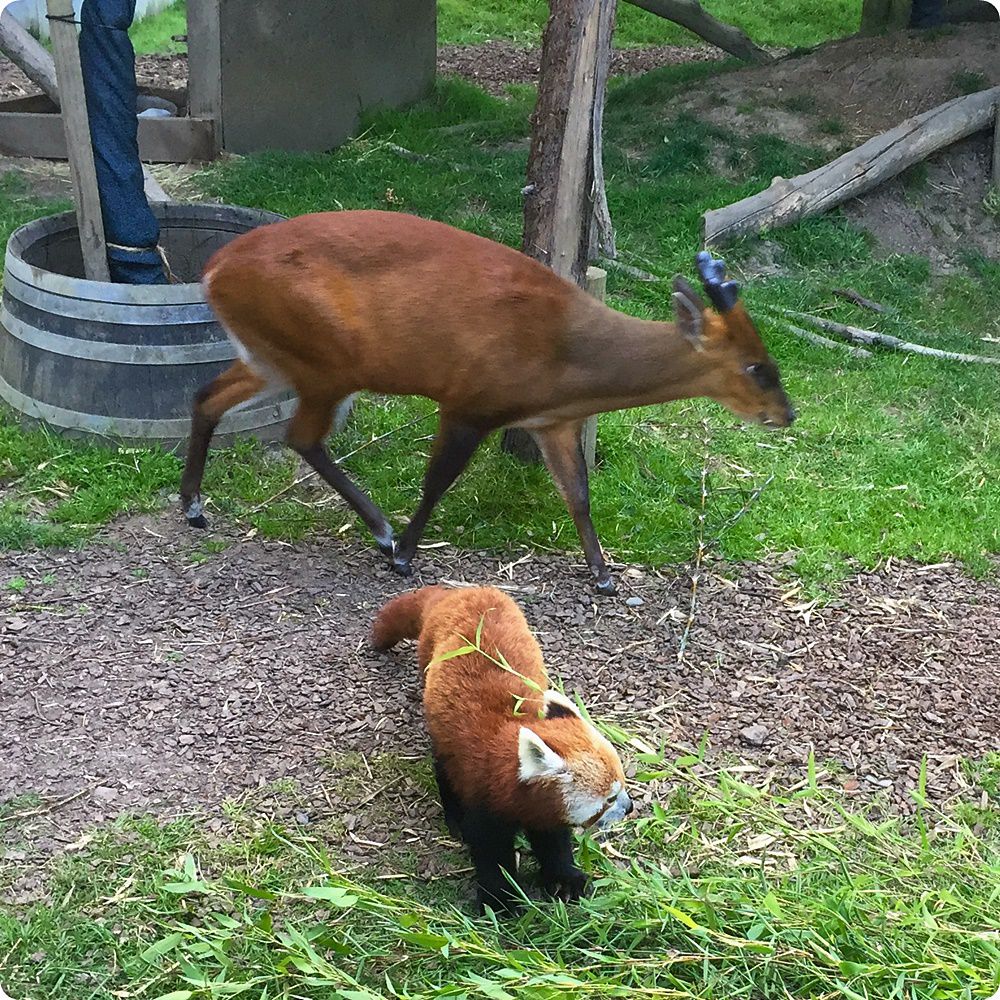
Red Panda (Ailurus fulgens) and Indian Muntjac (Muntiacus muntjak)
Sequioa Park Zoo, Eureka, California, United States of America
Photo © www.zoochat.com
Combined species:
- Red Panda, Ailurus fulgens
- Reeves’ Muntjac, Muntiacus reevesi
Institution(s): ARTIS Amsterdam Royal Zoo (the Netherlands), Dierenrijk (Mierlo, the Netherlands), Ouwehands Dierenpark (Rhenen, the Netherlands), Zoo Zürich (Switzerland), Bioparc - Zoo de Doué la Fontaine (France), Zoo de Lille (France), Tierpark Görlitz (Germany), Tiergarten Nürnberg (Germany), Opel-Zoo (Kronberg, Germany), Zoologischer Garten Halle – Bergzoo (Germany), Erlebnis – Zoo Hannover (Germany), Zoo Krefeld (Germany), Tierwelt Herberstein (Austria), Memphis Zoo (Tennessee, United States of America), Franklin Park Zoo (Boston, Massachusetts, United States of America), Rosamond Gifford Zoo (Syracuse, New York, United States of America), Calgary Zoo (Alberta, Canada), Zoo de Granby (Québec, Canada)
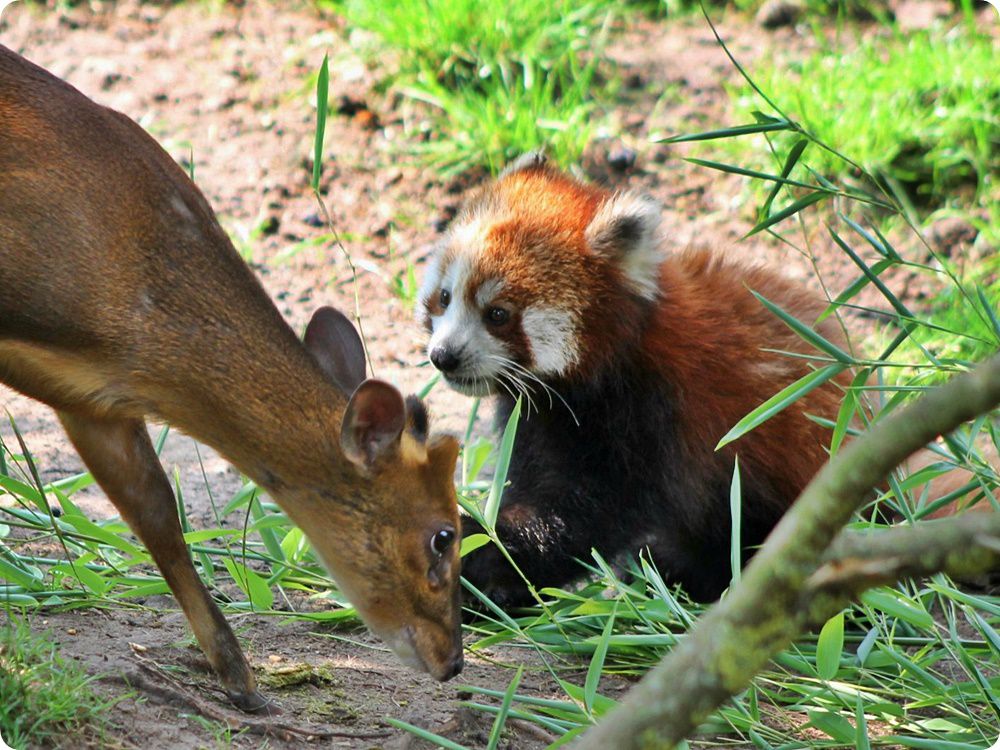
Western Red Panda (Ailurus fulgens fulgens) and Reeves' Muntjac (Muntiacus reevesi)
Dierenrijk, Mierlo, the Netherlands
Photo © Maarten de Ruiter
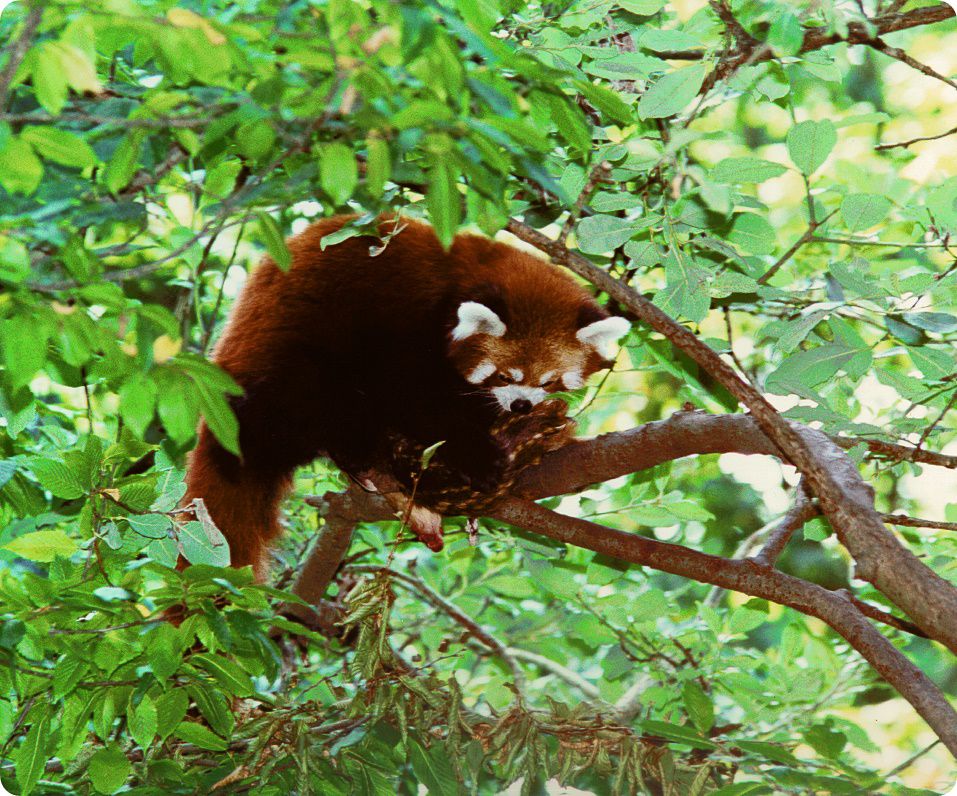
Western Red Panda (Ailurus fulgens fulgens) is feeding on a corpse of a few days old Reeves' Muntjac (Muntiacus reevesi)
Tiergarten Nürnberg, Germany
Photo © dr. Katrin Baumgartner
Combined species:
- Red Panda, Ailurus fulgens
- Reeves’ Muntjac, Muntiacus reevesi
- Blackbuck, Antilope cervicapra
Institution(s): Zoo Aquarium de Madrid (Spain)
Western Red Panda (Ailurus fulgens fulgens), Reeves' Mutjac (Muntiacus reevesi) and Blackbuck (Antilope cervicapra) mixed exhibit
Zoo Aquarium de Madrid, Spain
Photo © Alex Kantorovich
Combined species:
- Red Panda, Ailurus fulgens
- Reeves’ Muntjac, Muntiacus reevesi
- Common Shelduck, Tadorna tadorna
- Bewick’s Swan, Cygnus bewickii
Institution(s): GaiaZOO (Kerkrade, the Netherlands)
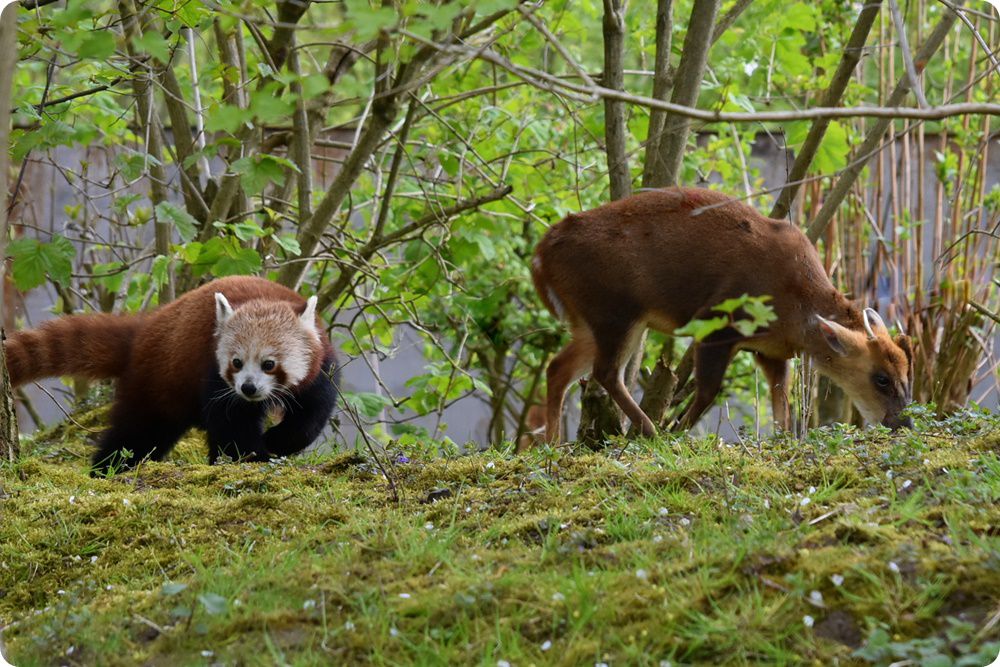
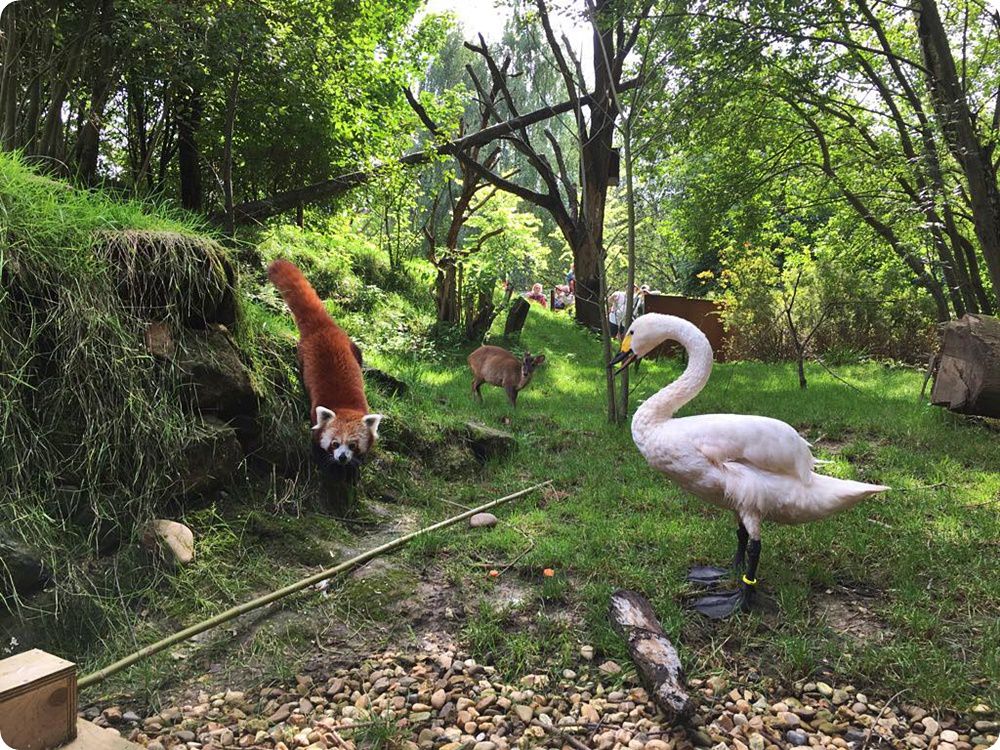
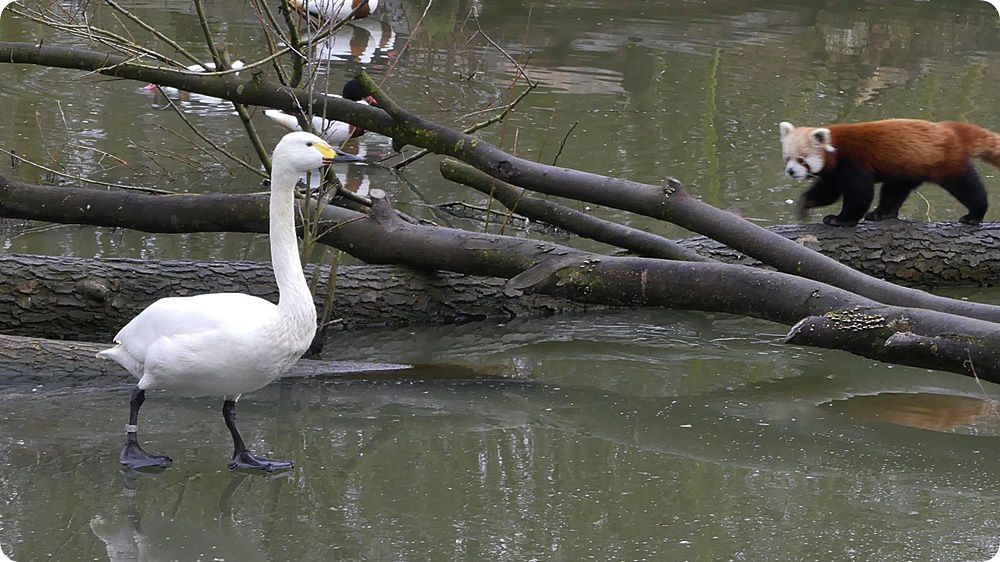
Western Red Panda (Ailurus fulgens fulgens), Reeves' Muntjac (Muntiacus reevesi), Common Shelduck (Tadorna tadorna) and Bewick's Swan (Cygnus bewickii) mixed exhibit
GaiaZOO, Kerkrade, the Netherlands
Photos © GaiaZOO
Combined species:
- Red Panda, Ailurus fulgens
- Reeves’ Muntjac, Muntiacus reevesi
- Red-crowned Crane, Grus japonensis
Institution(s): Réserve zoologique de la Haute-Touche (Obterre, France)
Combined species:
- Red Panda, Ailurus fulgens
- Reeves’ Muntjac, Muntiacus reevesi
- Black-necked Crane, Grus nigricollis
Institution(s): Zoologischer Garten Halle – Bergzoo (Germany)
Combined species:
- Red Panda, Ailurus fulgens
- Reeves’ Muntjac, Muntiacus reevesi
- White Eared-pheasant, Crossoptilon crossoptilon
- Red-billed Blue Magpie, Urocissa erythrorhyncha
Institution(s): Tierpark Görlitz (Germany)
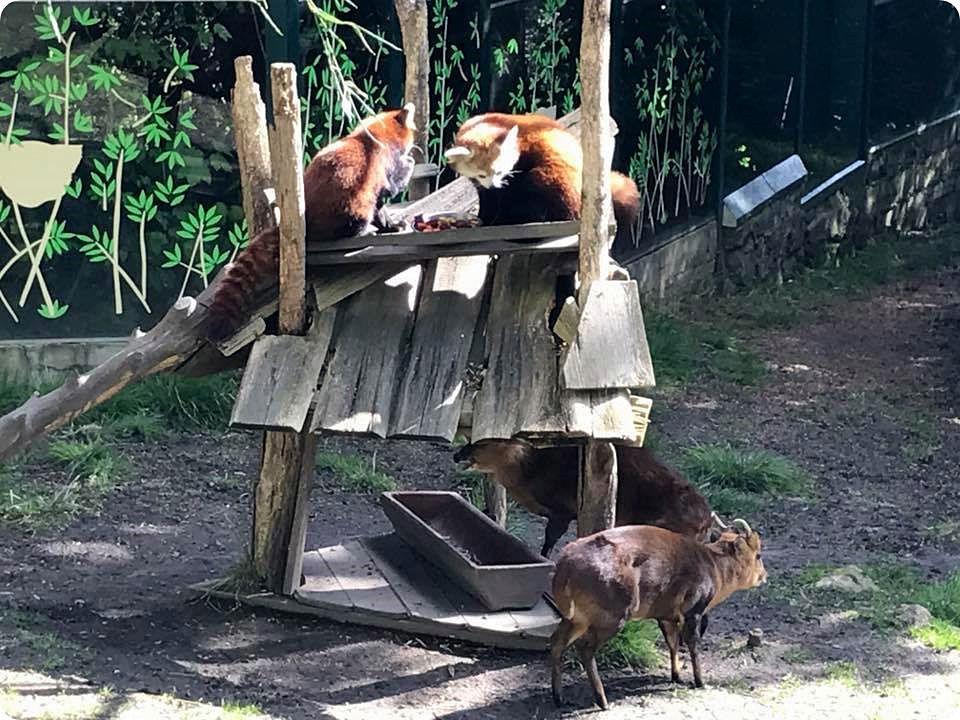
Western Red Pandas (Ailurus fulgens fulgens) and Reeves' Muntjacs (Muntiacus reevesi)
Tierpark Görlitz, Germany
Photo © Mario Berndtgen
Combined species:
- Red Panda, Ailurus fulgens
- Himalayan Tahr, Hemitragus jemlahicus
Institution(s): Tierpark Hagenbeck (Hamburg, Germany)
Western Red Pandas (Ailurus fulgens fulgens) and Himalayan Tahrs (Hemitragus jemlahicus)
Tierpark Hagenbeck, Hamburg, Germany
Photo © www.zoochat.com
Combined species:
- Red Panda, Ailurus fulgens
- Chinese Goral, Naemorhedus griseus
Institution(s): Minnesota Zoo (Minnesota, United States of America), Oglebay Good Zoo (Wheeling, West Virginia, United States of America), Zoologischer Garten Magdeburg (Germany)
Combined species:
- Red Panda, Ailurus fulgens
- Urial, Ovis vignei
Institution(s): Minnesota Zoo (Minnesota, United States of America)
Combined species:
- Red Panda, Ailurus fulgens
- Southern Cassowary, Casuarius casuarius
Institution(s): Bioparc Fuengirola (Spain)
Combined species:
- Red Panda, Ailurus fulgens
- Asian Small-clawed Otter, Aonyx cinereus
- Southern Cassowary, Casuarius casuarius
Institution(s): Bioparc Fuengirola (Spain)
Combined species:
- Red Panda, Ailurus fulgens
- Red-crowned Crane, Grus japonensis
- Mandarin Duck, Aix galericulata
- African Comb Duck, Sarkidiornis melanotos
Institution(s): Vogelpark Avifauna (Alphen aan den Rijn, the Netherlands)
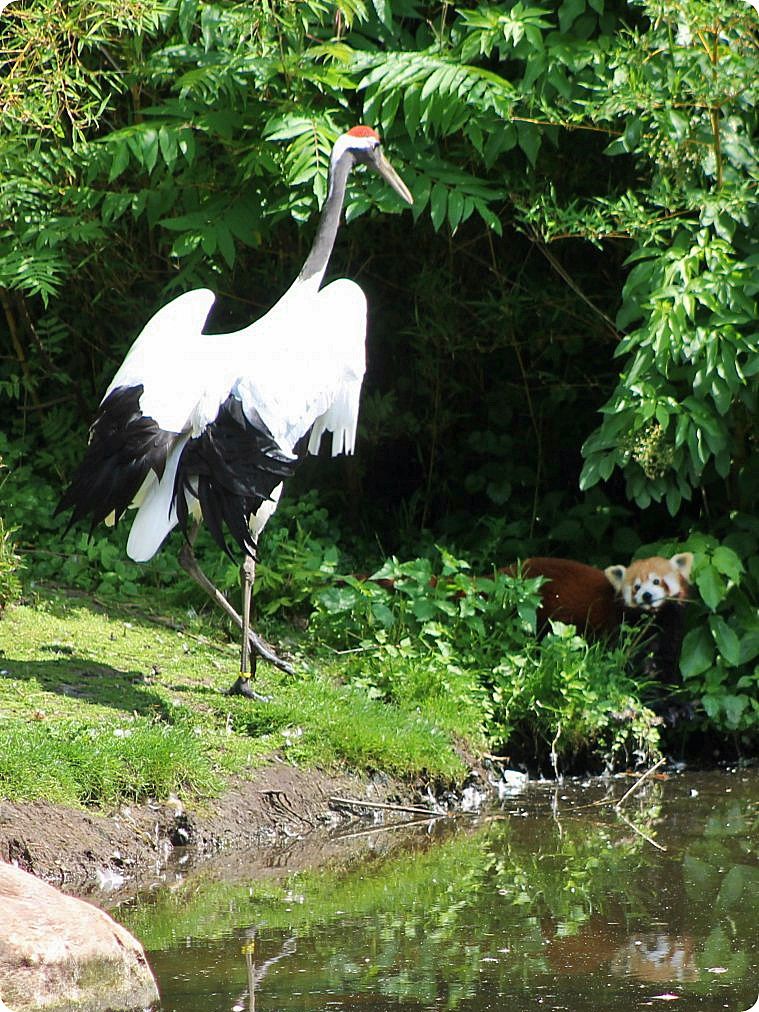
Western Red Panda (Ailurus fulgens fulgens) and Red-crowned Crane (Grus japonensis)
Vogelpark Avifauna, Alphen aan den Rijn, the Netherlands
Photo © Maarten de Ruiter
Combined species:
- Red Panda, Ailurus fulgens
- Black-necked Crane, Grus nigricollis
Institution(s): Zoologischer Garten Halle – Bergzoo (Germany)
Combined species:
- Red Panda, Ailurus fulgens
- White-naped Crane, Antigone vipio
unknown institution
Combined species:
- Red Panda, Ailurus fulgens
- Indian Peafowl, Pavo cristatus
Institution(s): Chengdu Panda Breeding Research Center (Chenghua, China)
Combined species:
- Red Panda, Ailurus fulgens
- Crocodile, Crocodylus sp.
Institution(s): Safari World (Bangkok, Thailand)
Combined species:
- Red Panda, Ailurus fulgens
- Koi, Cyprinus carpio
unknown institution
SUMMARIZE THE EXPERIENCES
This document purposefully focuses on creating a list of mixed-species exhibits with family Procyonidae and Ailuridae, for further and detailed information it is worth contacting the institutions mentioned above. Only a short summary of the general experiences is given here. Many of the listed coexistences are still ongoing at present; many of them are not anymore.
Raccoons
In Riyadh Zoo Northern Raccoons have had their own enclosure and Common Marmosets had access to them from the neighbouring enclosure for Central American Agoutis (HAMMER 2002).
The combination of Northern Raccoons and Crested Porcupines in Zoo Heidelberg worked well. It was only part-time coexistence, until the raccoons moved into their new enclosure, without problems, but for breeding both species had to be separated for a few days/weeks (REICHLER-DANIELOWSKI 2018, pers. comm.).
Heidelberg also tried another combination with their Northern Raccoons: the procyonids share their enclosure with a far smaller carnivore species. The coexistence with European mink is without any problems, the mink is the dominant species, but no experience with breeding until now. The park has wooden boxes for the mink, which are not accessible for the raccoons (REICHLER-DANIELOWSKI 2018, pers. comm.).
In Zoo Decin at moment they have only one Northern Raccoon is living together with several Coypus. The institution used to have the exhibit only for racoons, 3,3 animal at the beginning. They have had four wooden boxes for use (placed on the earth - exhibit is uphill), but they spent all the time on the big tree and did not use boxes. Food was scattered in the enclosure and racoons often started to feed immediately. Later on when the park introduced four Coypus into the enclosure the situation has changed. Of course, at the beginning racoons were eager to find out what Coypus are, and the rodents were nervous, but after few days it was okay. The staff did not see any interaction between species. Coypus started using boxes and dug their own additional dens. Racoons, as usual, were sleeping on the tree. For raccoons the keepers have made a feeding platform (to avoid competition for food) and big wooden box above the earth, both connected to the "raccoons tree" by rope ladder. During the time they lost raccoons due to falling from the tree (mostly strong wind or storm), so the park decided to catch them and close the way up the tree and from this time raccoons became "invisible". On that time Coypus had young offsprings and these dissapeared over the night. It is not known, if the raccoons did hunt them or Coypus killed the offspring due to stress. Later on when Coypus have had offspring again the staff saw, that racoons were interested in youngs, but were very quickly pushed back by the rodents (and relatively from long distance) and did not try to close them again. Coypuses have rised offspring several times. Even racoons have rised youngs one time. So in the end - these species can live together, respect each other, keep a distance from each other. May compete for food, pond or resting places, depending on conditions. Both species are able to breed. (RUS 2018, pers. comm.).
Keeping Northern Raccoons with Raccoon Dogs is an old story in Berne, it has worked now for many years, maybe also due to the large enclosure (ROSSET 2018, pers. comm.).
The Minnesota Zoo on its Minnesota Trail (North American Native species) currently has Northern Raccoon and Red Fox mixed. These two animals were wild orphan animals that were confiscated from a private individual; both animals were raised in the person's house with domestic dogs and cats as well as a North American River Otter. This has worked well for the park as the fox frequently plays with the raccoon, but it is not known that they would repeat this again given the unique background of these two animals being raised in a human environment and very imprinted (NESS 2018, pers. comm.).
Zoo Braunschweig has been keeping Northern Raccoons and Striped Skunks together successfully in an enclosure since 2002. There are currently 10 raccoons (all castrated) along with 5 male skunks (uncastrated and stink glands present). When their raccoons had raised offspring, the skunks were not a problem, even though they had contact with the offspring (WILHELM 2018, pers. comm.).
Norhern Raccoons, Striped Skunks and North American Woodchucks have been housed together successfully with very little aggressive interaction. It is important that appropriate shelter and denning facilities be provided for each species, and that feeding/watering stations are established to minimize aggression over food (G. Granat, unpublished information, 2003). Raccoons also have been housed with coatis and Silver, Red and Arctic Fox (K. Schilling, personal experience). In the latter instances, there may be some aggression at feeding time, which should be anticipated and prevented by offering multiple feeding locations. In the past, ex situ populations of raccoons and fox have shown an inclination to share den boxes, especially in cold climates, even when multiple denning locations were provided (K. Schilling, personal experience) (AZA Small Carnivore TAG 2010).
In Los Angeles Zoo Northern Raccoons and North American Badgers were mixed in a 70 m² enclosure but the latter ones were separeted over night. A fight between the males caused injuries, but the animals were integrated again successfully (CROTTY 1981, HAMMER 2002).
In Zoopark Chomutov Northern Raccoons share a large wooden area with Ouessant sheep. The coexistence of both species is completely seamless and there are no problems between the two species (BRTNICKŶ 2018, pers. comm.).
One of the most unique and interesting combination is found in ZooParc Overloon in the Netherlands where three species of carnivorans – Crab-eating Raccoon, Bush Dog and White-nosed Coati – exhibited together. This goes quite well also and creates a lot of interactive behaviour between the species (HEUVEL 2018, pers. comm.).
In associations with Raccoons it is absolutely has to be paid attention to good hygiene and control parasites. They are very often carriers of a Round Worm (Baylisascaris procyonis), which can cause a cerebrospinal nematodiasis in other mammals and therefore can be very dangerous for other occupants (HAMMER 2002).
In Los Angeles Zoo South American Coatis and Geoffroy’s Spider Monkeys have been mixed some decades ago. One curious monkey died on wounds, perhaps caused/inflicted from a coati (CROTTY 1981, HAMMER 2002).
In Zoo Rostock a male group of South American Coatis have been kept together with Black-capped Capuchins in a 950 m² size enclosure many years ago. Species were habituated to each other while separated by wire mesh. When group size of the coatis was enlarged, conspecifics were habituated to each other first. Then they were associated with the capuchins. Occasionally the monkeys pull hair of coatis but they did not seem to be disturbed by this kind of interaction and tolerate this behaviour. When the coatis approached feeding spots, they displaced the primates. Both species respected each other and no major problems were occured between them, only sometimes minor injuries that might have been caused by the coatis. All together this association can be recommended. When monkeys were released to the outdoor area for the first time, some individuals jumped on – and over the rather low (1.1m) fences, regardless of the hot wires. But after these first experiences and habituation of monkeys to the large outdoor enclosure, this reduced kind of fencing proved to be sufficient (ZIEGLER 2002).
The same combination has also been tried in Plaswijckpark, Rotterdam. The park has a mixed cage with a group of female coatis (0.5) and a male group of capuchins (2.0). The cage was originally designed only for capuchin monkeys, the enclosure is distributed in two areas, one internal and another external, both areas have enriched environment objects and of course visual access for the visitors. Time ago the institution had an enclosure exclusively for coatis, they were an old group and with the time they died, with the remodeling of the park the shelter was modified for other purposes. The park observed that in other zoos the mixed enclosures were a big success and after a biogeographical review they were decided that the coatis could be a good option in the enclosure of the capuchin monkeys and the enclorue was suitable enough for both. The introduction of the coatis to the enclosure of the monkeys was carried out gradually, first with olfactory contact, then visual contact through glass and finally direct contact. The hierarchy and territoriality between the animals inside the cage has been successful the following months after the introduction and without a dangerous aggresion between them (RAMOS and ZWART 2018, pers. comm.).
In Zoologischer Garten Schwerin a very unique coexistence has been tried with three species: South American Coatis live together with Bearded Capuchins and Collared Peccaries. With the help of ropes, the monkeys and the coatis have access to the tree canopy. One of the new climbing trees is outside of the enclosure and the rope guides passes over the visitor’s path. This tree serves as a retareat for the capuchins as the the rope is too thin for the heavier coatis (SCHIKORA 2017).
In Zoo Praha a South American Coati (1.0, neutered) and White-nosed Coatis (0.2) were exhibited together with Patagonian Maras. It did work only with adult animals. Surprisingly, the two very old non-reproductive maras gave birth after the transfer to the new environment, the young was killed and eaten by coatis immediately. One of the adult maras died because of the age and the other one injured itself not caused by coatis. The injured animal was then killed and chewed by coatis, the staff found it in the morning. So the combination is good for adult and healthy animals only (BRANDL 2018, pers. comm.).
South American Coati has also been tried together with Guinea Pig in Adelaide Zoo to trial to see if the zoo might try them with Red-rumped Agouti. Unfortunately that did not work as the coati ate the Guinea Pig (GUY 2018, pers. comm.).
In Twycross Zoo one South American Coati was killed by a group of Bush Dogs containing with even more individuals (LIPTOVSZKY 2018, pers. comm.).
The South American Coati & Spectacled Bear combination is one of the most frequent association with the species which has been tried out in many zoological institutions. It was reported from Los Angeles Zoo that the two species have had offspring in the same time during exhibited together (DEE 1988).
Madrid Zoo does not have any more the combination of South American Coati with Sun Bear and Spectacled Bear as the institution stopped keeping coatis, so, when the last one died due to its old age this combination stopped, but this coexistence was quite good, the zoo had not recognized any problem at all between them, the coatis had spaces free of bears but they did not really need them (DELCLAUX 2018, pers. comm.).
In Zoo Zürich South American Coatis and Spectacled Bears live together. The park has no problems with the coexistence and it still works very well. When a new male coati arrived it took only a few weeks to get him used to the enclosure and for the bears. There are some pipes in the enclosure that form tunnels below the ground so the coatis can pass through but the bears cannot. Sometimes the two species are foraging very close to each other. The institution even had a quite old female coati that moves very wiggled because of an old injury (not caused by the bears). She was not very fast but never had problems of being chased. Just when the coatis were rearing pups the staff make sure that they did not share the same enclosure (GALEFFI 2012, pers. comm.). The male Spectacled Bear is still living together with the coatis (LODDENKEMPER 2018, pers. comm.)
Some years beforehand Jersey Zoo has mixed their female group of South American Coatis with a breeding pair of Spectacled Bear and also with a big group of Black Howler Monkeys. Before that Asian Small-clawed Otters also housed with these species (COWAN et al. 1999). The institution has had very few problems with these species mixing together, although there was one occurrence where an otter died from being hit by the bear (the otter was trying to steal the bears food) but this happened in the early stages of the mixed exhibit. The total outside area of the enclosure is 1700 m² with the inside building partially buried in the middle. The outside enclosure is designed so that it can either be used as one large area or be split into two separate areas using gates at both the front and back of the enclosure. There is also a most which surround the outside enclosure which the bears enjoy swimming in and was also utilised by the otters when they were present in the enclosure. The outside has been designed to accommodate all of our animals with large tree trunks for the bears to climb and smaller trees and rope for the monkeys and coatis to use. The inside enclosure is split into six dens, each den has both a large sliding door for the bears and a smaller door with a tunnel exit for the coatis and otter when they were mixed. The howlers shut into their den in overnight as a precaution but the coatis have outside access continuously. The bears get most of their feeds outside on the west side of the enclosure (if weather is very bad they will receive their food inside), although do get some scatter on the east side for enrichment. Coatis receive their feeds on the east side of the enclosure (again inside in their den if the weather is bad), they do always get fed their protein inside so that we can check them closely once a day. Howler monkeys have their main feed at the end of the day when they are shut into their den; is summer they spend a large portion of their day outside browsing on the trees, during the winter they share the inside with the coatis and get their leafy greens inside. The coatis and howlers are fairly tolerant of each other and can be seen feeding near each other. They do get the occasional quarrel, but this is usually the juvenile howler monkeys annoying the coatis like poking and jumping on them. They have had several occurrences now of the female howler monkeys giving birth whilst with the coatis and all has been well. The coatis and the howlers are quite watchful of the bears and often retreat to the trees when the bears get too close. Usually if the bears show too much interest in the howler monkeys the group start to display and the bears loose interest and walk off. The most interaction they had was between the bears and the otter, the female otter was especially naughty and loved to sneak up behind the bears and bite their bottom or ankles. Luckily she was too quick for them to retaliate and just ran away. She could also be seen during the winter to sleep inside with the bears quite close (HUNT 2012, pers. comm.).
Opel-Zoo in Kronberg kept together their South American Coatis with Striped Skunks in a 77 m² size enclosure. There were no overt aggression, but after two months skunks only became active at night (HAMMER 2002).
In Apenheul Primate Park South American Coatis mixed with Asian Small-clawed Otters in a 500 m² size exhibit. The species were separated over night. After six month of peace they suddenly started to fight, where as the otters dragged one coati into the water moat in an attempt to drown him. It could be possible that they wanted to use a parental behaviour (as teach their young to swim and dive by a very brutal mode) on the coatis as well. But if the reasons for this behaviour have been aggressive or parental-educating against the coatis for the poor coatis the result was the same, so the species had to be separated again (HAMMER 2002).
The Amazonia exhibit in Zoologischer Garten Magdeburg show a rare combination in zoo: South American Coatis (5.1) and White-nosed Coatis (1.2) (both coati species breeding) with South American Tapirs. Outside no problems at all, coatis and tapirs mostly ignore each other, sometimes coatis are scratching and resting on tapirs, furthermore jumping on them during playing, but tapirs seem to like the stroke. Coatis are building tree nests outside. The combination inside was not possible, as coatis used tapirs as jumping platform to escape to the visitor hall, as well as too much scratching of tapirs when all the day together (RUSKE 2018, pers. comm.).
The Papiliorama in Kerzers kept one male White-nosed Coati with a breeding group of Collared Pecary. The reason the institution has tried this combination was that their coatis would be transferred to another zoo but they did not know how long it would take until the paperwork was finished to send them out. As the zoo did not want to keep any of their coati behind the scenes nor put it on birth control they decided to keep the male and female separately. The staff chose the peccary enclosure as it is next to the coati enclosure, only separated by wire mesh. This way the coatis could stay in contact with each other. On first sight things worked out well but probably it was more stressful for the peccaries then was obvious on first sight. The first offspring of the peccaries that was born after the coati was introduced was eaten by the coati. It is not clear if the new born peccary was still-born or if the coati killed it. In any case the peccary did not get any offspring anymore until months after the coati was moved out again (RÜEGG 2018, pers. comm.)
Further combinations with the White-nosed Coatis have been mentioned above in ZooParc Overloon and Zoo Praha.
Neutered coatis have been successfully maintained in an enclosure with neutered raccoons, and one old coati was housed with a pair of striped skunks (K. Schilling, personal experience). These animals were introduced as adults. One institution successfully housed an adult male coati with an adult male Capybara (S. Carter, personal communication). At one AZA-accredited institution, coatis were exhibited with spectacled bear, while another institution exhibited them with squirrel monkeys. In the latter combination, the squirrel monkeys were reported as being prone to showing aggression towards coati young, even stealing and killing them at times (AZA Small Carnivore TAG 2010).
Inside the Nocturama dome in the Papiliorama the Kinkajous can be seen together with Linné’s Two-toed Sloths and Six-banded Armadillo. Generally this combination works but it was difficult monitoring the amount of food the sloth was getting as the Kinkajous would be a lot faster getting to the food plates (RÜEGG 2018, pers. comm.).
Burgers’ Zoo in Arnhem tried to kept together their Ringtails with Striped Skunks in a 50 m² exhibit since 1994. The combination worked very well. Ringtails were separated during mating season (HAMMER 2002). The interaction with the Ringtail was very limited, but the species tolerated each other. The only issue was the feeding: the Ringtails are more shy so the keepers needed to feed them separate. This is very easy by creating places were the skunks could not come (HUIZINGA 2018, pers. comm.).
Red Panda
Red Pandas and primates have also been combined in Zoo Osnabrück where Siamangs lived together with the small carnivorans. Due to the harassment of the gibbons the mixed exhibit has been given up.
ZooParc Overloon does not have the former Binturong & Asian Small-clawed Otter coexistence anymore as the viverrids always escaped. Now the zoo changed this combination to Asian Small-clawed Otters and Red Pandas which goes quite well together (HEUVEL 2018, pers. comm.).
In Mulhouse two female Red Pandas share their exhibit with a group of Asian Small-clawed Otter and with Reeves’ Muntjacs. The cohabitation is going quite well and sometimes the park have funny situations. The otters tend to be a pain for the Red Pandas because they love to climb in the trees and disturb them sometimes but nothing really problematic. There was electric fence but the otters would climb anyway so they removed it. For the food the keepers sometimes have to be careful as one female Red Pandas like to go down into the muntjacs’ holdings to steal some apple pieces (BACONNAIS 2018, pers. comm.).
Bioparc Fuengirola has a unique mixed exhibit system. There are a Red Panda & Southern Cassowary mixed exhibit and a Bornean Orangutan enclosure next to each other. The Asian Small-clawed Otters are using daily the orangutan enclosure at the same time without problems. The otters can use also the adjacent enclosure where the Red Pandas and cassowaries live but as this enclosure does not have a large pond, they prefer to spend most of the time in the orangutan enclosure. There is a small otter-sized door hidden on the rocks, so the otter can go from one enclosure to the other. The cassowaries sometimes chase the otters, but the much more clever otters just avoid them easily. The Red Pandas rarely came to the ground and so far the staff have not seen a problem with the cassowaries or with the otters. This pair of cassowaries are extraordinarily peaceful even with the keepers, so it might be difficult with other specimens (RECUERO 2018, pers. comm.).
The most frequent association is the Red Panda & Reeves’ Muntjac coexistence which has been tried in many European and North American institutions. According to the Red Panda Care Manual (AZA Small Carnivore TAG 2012) and EAZA Best Practice Guidelines for the Red Panda (EAZA Small Carnivore TAG 2015) the following experiences were listed in reference to the Red Panda & Reeves’ Muntjac coexistence: both species share the exhibit during the day, the pandas were closed into their shelter and separated from the muntjacs overnight; need a nice slow-intro then non-breeders seem to do fine; a muntjac ended up breaking its leg trying to get out of the exhibit and panicking with people around; during breeding season for the pandas, pandas sometimes became aggressive: they were aggressive towards muntjac fawns and can kill muntjacs.
In Nürnberg the two species lived together in a 585 m² sized enclosure with several living trees, bushes and grass on natural ground. The 20 m² indoor facility with two compartments permanently accessible for both species, but only one equipped with climbing structures. The muntjacs were habituated first to the enclosure. Adult muntjacs seemed to be dominant over Red Pandas and used to displace them. After the muntjacs successfully reared their offspring several times in presence of Red Pandas, the fourth (2000) and the sixth infant (2001) was killed and partly devoured by a Red Panda in the outdoor enclosure. A third victim (2002) was lightly wounded. Pregnant deer should be separated before delivery. 1-2 weeks after birth, infant deer are out of danger. Additional provision with nonvegetable proteins did not affect Red Pandas behaviour (ZIEGLER 2002).
The cohabitation of the two species in Nürnberg has to be terminated after many years, when an aggressive male muntjac killed both two Red Pandas by slitting their belly with his hoof. This individual hurt his females some months later on the back as well. The pandas have killed and eaten four only one to three days old young muntjacs while five could be raised up without any problems (MÄGDEFRAU 2018, pers. comm.).
Zoo Aquarium de Madrid exhibits their Red Pandas together with Reeves’ Muntjacs and Blackbucks. The staff have had some problems as the pandas sometimes have attacked the muntjacs, especially the young ones, causing them some injuries, mainly in the tail area. The zoo is not breeding the muntjacs anymore, so, nowadays they do not have more injuries (DELCLAUX 2018, pers. comm.).
In Tierpark Görlitz the Red Panda & Reeves’ Muntjac combination is still successful. Beforehand birds were also exhibited with them in a 1500 m² enclosure, but after one year peacefully living together, the pandas attacked the White Eared-pheasants and injured them (HAMMER 2002).
GaiaZOO in Kerkrade keeps their Red Pandas together with Reeves’ Muntjacs, Common Shelducks and Bewick’s Swans. This combination works well, though the keepers have to make sure that every species get it's food properly (BOER 2018, pers. comm.).
An other muntjac species, Indian Muntjac was also associated with Red Pandas in Zoo Heidelberg. The 565 m² exhibit with a big central walnut-tree on natural ground with grass, bamboo and bushes, dead wood and rocks. The indoor facility was 20 m² big with branches and sleeping boxes and feeding boards for the pandas. Muntjacs were initially kept in the indoor enclosure for several days, while Red Pandas had access to both enclosures through sliding doors in the upper level. Muntjacs were regularly waiting for food items, dropped by the pandas, to feed on (ZIEGLER 2002).
It is worth mentioning that the Red Panda & Tufted Deer cohabitation is becoming more and more popular, at moment at least four European institutions have that. This combination in Heidelberg works quite well without any problems, even if they (both) breed (REICHLER-DANIELOWSKI 2018, pers. comm.).
Minnesota Zoo has no longer have their Red Pandas and Chinese Gorals together, but that is because their last goral died of old age and they switched to Urial. So that habitat is now for Red Panda and Urial, they have also not had any issues with these two species, although they do not interact much (NESS 2018, pers. comm.). The previous panda and goral combination was also successful as the species ignored each other (AZA Small Carnivore TAG 2012, EAZA Small Carnivore TAG 2015).
ACKNOWLEDGEMENTS
I would like to thank all the persons very much who helped to improve this short summary with providing information and photographs as well, in particulare:
Marine BACONNAIS Lead Keeper/Curator (Parc Zoologique et Botanique de Mulhouse, France), Hanneke de BOER Education & Conservation (GaiaZOO, Kerkrade, the Netherlands), Dr. Pavel BRANDL Curator (Zoologická zahrada hl. m. Prahy, Czech Republic), Miroslav BRTNICKŶ Zoologist (Podkrušnohorský zoopark Chomutov, Czech Republic), Maria DELCLAUX Curator of Mammals (Zoo Aquarium de Madrid, Spain), Cordula GALEFFI Curator (Zoo Zürich, Switzerland), Sharon GRANT Visitor Experience Officer (Zoos South Australia, Royal Zoological Society of South Australia, Australia), Murray GUY Animal Records Officer (Adelaide Zoo, Australia), Steven van den HEUVEL Head Keeper/Curator (ZooParc Overloon, the Netherlands), Willeke HUIZINGA Curator of Bush, Desert and Mangrove (Koninklijke Burgers’ Zoo, Arnhem, the Netherlands), Jenna HUNT Senior Mammal Keeper (Jersey Zoo, Trinity, Channel Islands), Alex KANTOROVICH Euroasian Regional Coordinator at Species360 and Curator (Hai Park, Kiryat Motzkin, Israel), José KOK Zoological Director (Ouwehands Dierenpark, Rhenen, the Netherlands), dr. Mátyás LIPTOVSZKY Head of Life Sciences (Twycross Zoo, United Kingdom), Dirk LODDENKEMPER Curator (Zoo Zürich, Switzerland), Dr. Helmut MÄGDEFRAU Director (Tiergarten Nürnberg, Germany), Antal NAGY Zoo Educator (Pécsi Állatkert és Akvárium-Terrárium, Hungary), Tom NESS, AZA Population Biologist & Tropics and Minnesotra Trail Curator (Minnesota Zoological Gardens, Minnesota, United States of America), Matthias PAPIES Curator of Mammals (ZOO Antwerpen, Belgium), Ernesto RAMOS Zookeeper (Plaswijckpark, Rotterdam, the Netherlands), Jesus RECUERO Veterinarian & Curator (Bioparc Fuengirola, Spain), Sandra REICHLER-DANIELOWSKI Curator (Zoo Heidelberg, Germany), dr. Marc ROSSET Curator (Tierpark Dählhölzli, Bern, Switzerland), Tomáš RUS Assistant Zoologist (Zoologická zahrada Děčín, Czech Republic), Konstantin RUSKE Curator (Zoologischer Garten Magdeburg, Germany), Peggy RÜEGG - van den BROEK Curator (Papiliorama, Kerzers, Switzerland), René RYHOLL Animal Department Assistant (Ree Park Safari, Ebeltoft, Denmark), Brooke WARDROP Senior Director of Marketing and Communications (Zoo New England, Boston, Massachusetts, United States of America), Janno WEERMAN Curator/Team Leader Asia Section (Diergaarde Blijdorp, Rotterdam, the Netherlands), Peter WILHELM Curator/Head Keeper (Zoo Braunschweig ’Arche Noah’, Germany), Kari WILLIAMS Conservation, Research & Sustainability (CRS) Coordinator (Milwaukee County Zoo, Wisconsin, United States of America), Dr. Emiko WONG Director of Live Collections, Conservation & Research (Biodôme de Montréal, Québec, Canada), Joyce ZWART Team Leader (Plaswijckpark, Rotterdam, the Netherlands)
As well as I would like to thank all the persons very much who helped to improve this document with providing further photographs, their names are listed below:
Dr. Katrin BAUMGARTNER, Mario BERNDTGEN, Tom van DEUREN, Cláudio DIAS TIMM, Allan GALWAY, Ben GILBERT, Örs GÖRÖG, Nick HADAD, Paul IRVEN, Alexander MEYER, Andrew O’CONNOR, Maarten de RUITER, Dominique VILLISECK
References:
AMEND, M. 2018. Nachttierhäuser in Zoologischen Gärten. Arbeitsplatz Zoo Sonderausgabe. Berufsverband der Zootierpfleger e. V., Druckerei & Verlag Fabian Hille, Dresden.
AZA Small Carnivore TAG 2010. Procyonid (Procyonidae) Care Manual. Association of Zoos and Aquariums, Silver Spring, MD. p.114.
AZA Small Carnivore TAG 2012. Red Panda (Ailurus fulgens) Care Manual. Association of Zoos and Aquariums, Silver Spring, MD. pp. 90.
COWAN, K., DARWENT, M. & RIVA, C. 1999. The design of First Impressions, a new multi-species enclosure at Jersey Zoo. The Durrell Wildlife Conservation Trust. The Dodo 35:8-25.
CROTTY, M. 1981. Mixed species exhibits at the Los Angeles Zoo. International Zoo Yearbook 21: Pp. 203-206.
DEE, M. 1988. The management of spectacled bears at the Los Angeles Zoo. Proceedings of the First International Symposium on the Spectacled Bears, Lioncoln Park Zoo, Chicago, Illinois, USA. October 1988 1, 111-113.
EAZA Small Carnivore TAG 2015. EAZA Best Practice Guidelines, Red Panda (Ailurus fulgens). Diergaarde Blijdorp, Rotterdam Zoo.
HAMMER, G. 2002. Mixed species exhibits involved mammals: stock report and problems. Dissertation. Naturwissenschaftliche Fakultät Universität Salzburg.
SCHIKORA, T. 2017. Seltene Vergesellschaftung im Zoo Schwerin. Pressemitteilung.
ZIEGLER, T. 2002. Selected Mixed Species Exhibits in Zoological Gardens. Primate Report 64. Selected Mixed Species Exhibits of Primates in German Zoological Gardens. Pp. 7-71.
ZIEGLER, T. 2002. Selected Mixed Species Exhibits in Zoological Gardens. Primate Report 64. Selected Mixed Species Exhibits with Mammals without Primates Involved. Pp. 72-84.
Comments

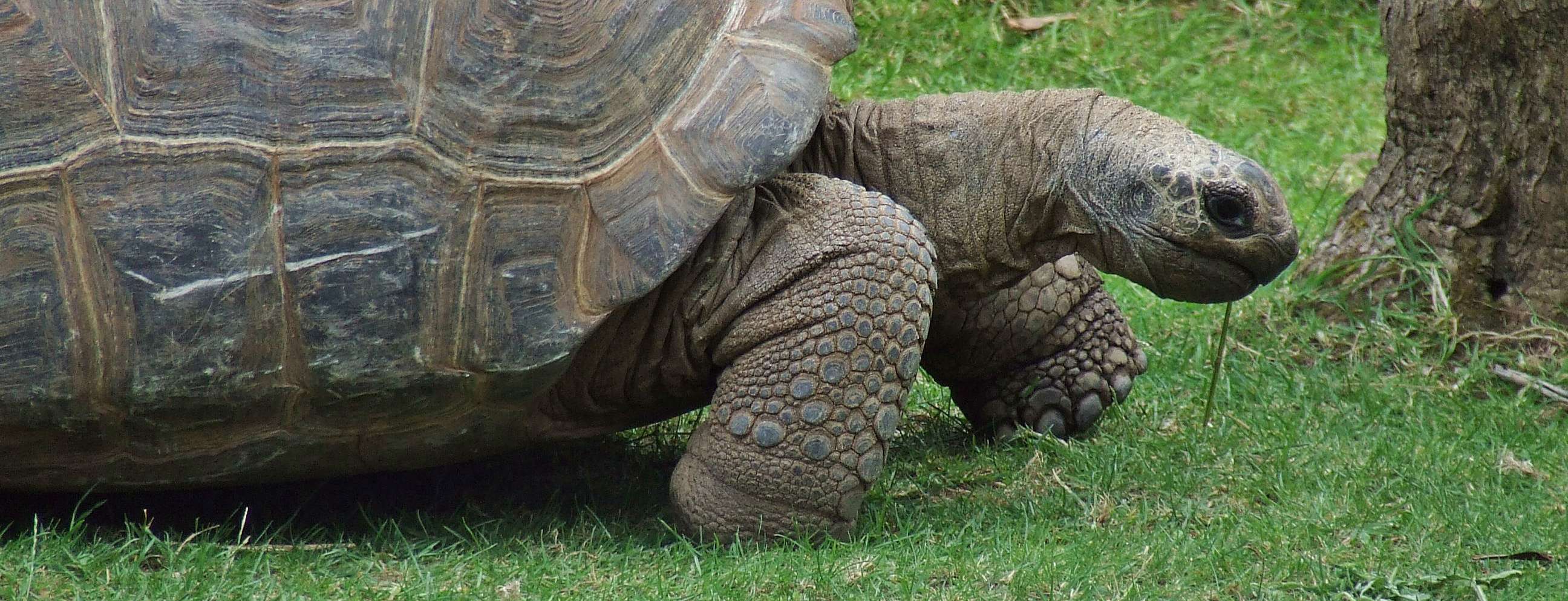
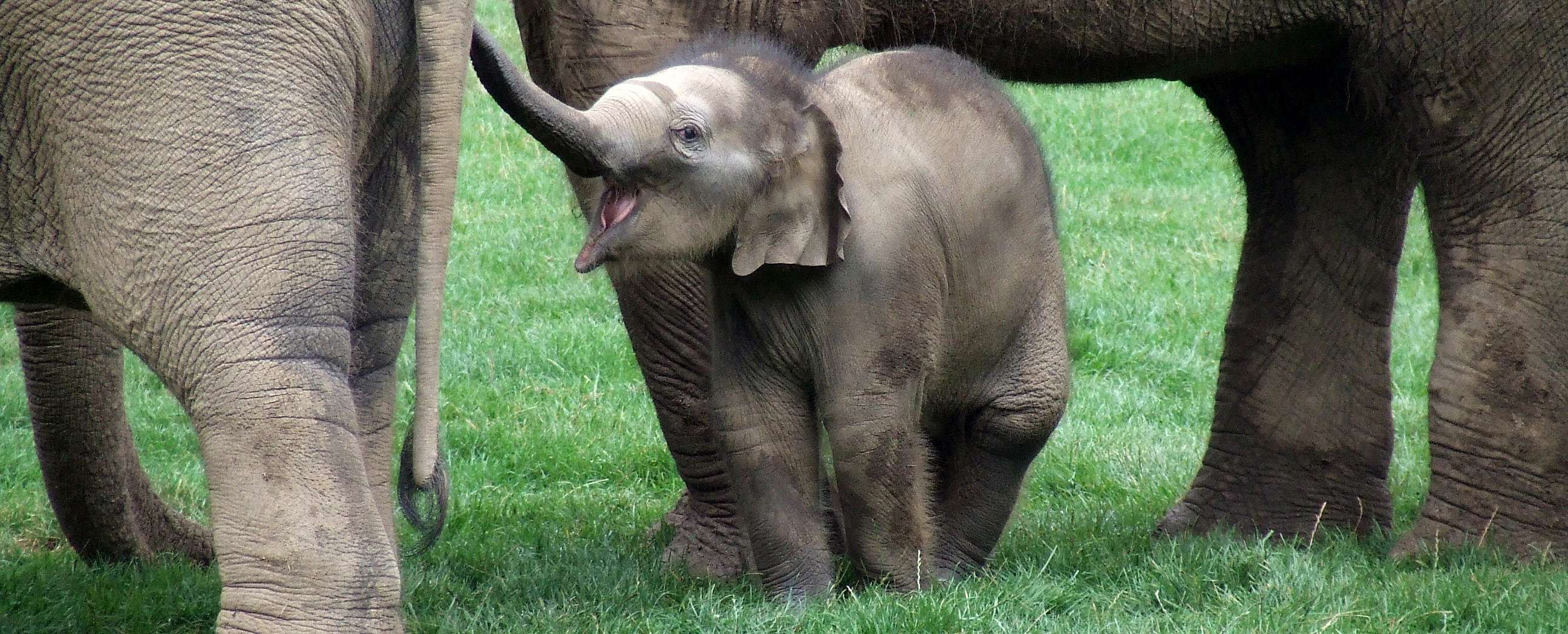







The cohabitation of the two species in Nürnberg has to be terminated after many years, when an aggressive male muntjac killed both two Red Pandas by slitting their belly with his hoof.
Now THATS morbid :/
Anyway what do you think about red panda + raccoon mixed exhibits? Could that work, or they would hurt each other?
Have they tried that out?